Capua Leads ECIS to Victory in
Joshua Capua, a Grade 12 East Central Integrated School (ECIS) student, is poised to lead his basketball team to victory in the upcoming Dagupan City Athletic Association (DCAA) games this December.


Capua Leads ECIS to Victory in
Joshua Capua, a Grade 12 East Central Integrated School (ECIS) student, is poised to lead his basketball team to victory in the upcoming Dagupan City Athletic Association (DCAA) games this December.


City Region I | August - October 2024



By: Clarissa Barozo
DAGUPAN CITY, PANGASINAN – Alarm bells are ringing for bangus (milkfish) growers in Pangasinan, including those in Dagupan City, as they reel from rapidly declining prices.
The farmgate price of bangus, now ranging from P90 to P110 per kilo, is below the production cost of P125 to P135 per kilo, threatening to derail the province’s multi-million-peso aquaculture industry.
During a recent dialogue, fish cage operators in Dagupan and nearby towns sought the intervention of the Bureau of Fisheries and Aquatic Resources (BFAR) and other concerned agencies to stop the collapse of the bangus industry.
Bangus producers expressed frustration over the price drop, which began in February.
Despite selling for as much as P120 to P200 per kilo in May, current prices have dipped significantly.
Christopher Aldo Sibayan, president of the Samahan ng
Magbabangus sa Pangasinan, voiced the concerns of bangus producers, saying that the current price is insufficient to cover production costs.
“We’re not even breaking even,” Sibayan lamented.
He added that the community has been facing seasonal price declines for the past four years, but this time, the impact feels particularly severe.
“We need to understand why this keeps happening. What’s missing, and what actions can the government take to prevent us from experiencing this season of loss?” Sibayan questioned during the dialogue.
Local Families Struggling Due to Price Drop
The declining prices have rippled through the entire community, particularly affecting fisherfolk like Jolo Reyes, who operates a small fish cage in Dagupan.
Jolo, a father of three, including Jovan Reyes, a East Central Integrated School student, shared how the falling prices have


drastically reduced their household income.
“Kulang na ang pambili ng feeds at maintenance dahil maliit ang kita ilang buwan na. Kailangan bawasan ang arawaraw na gastusin. Hindi talaga sapat and kinikita ko dahil sa problemang ito,” Jolo said.
Jovan, a Grade 7 student, echoed his father’s concerns.
“Minsan kasama ako nila ako na nanghuhuli ng isa. Hindi na ako nakakapasok dahil alam ko na problem ni Papa ang gastusin. Sana mabawi nila ang gastos nila,” Jovan said.

By: JB Parohinog
DAGUPAN CITY, Pangasinan—The discontinuation of mother tongue instruction in classes from Kindergarten to Grade 3 has sparked a heated debate among citizens following the enactment of Republic Act No. 12027.
The bill lapsed into law without the signature of President Ferdinand Marcos Jr.
It amends the Enhanced Basic Education Act of 2013, or Republic Act 10533, which mandated the Mother Tongue-Based Multilingual Education (MTB-MLE) program.
Under the Enhanced Basic Education Act of 2013, the mother tongue became the medium of instruction to enhance comprehension and literacy among young learners.
With the passage of RA 12027, “the medium of instruction shall revert to Filipino and until otherwise provided by law, English.”
While regional languages may still be used as supplementary teaching tools, the changes have sparked significant concern among educators and students.
“This is another adjustment for the
but
are
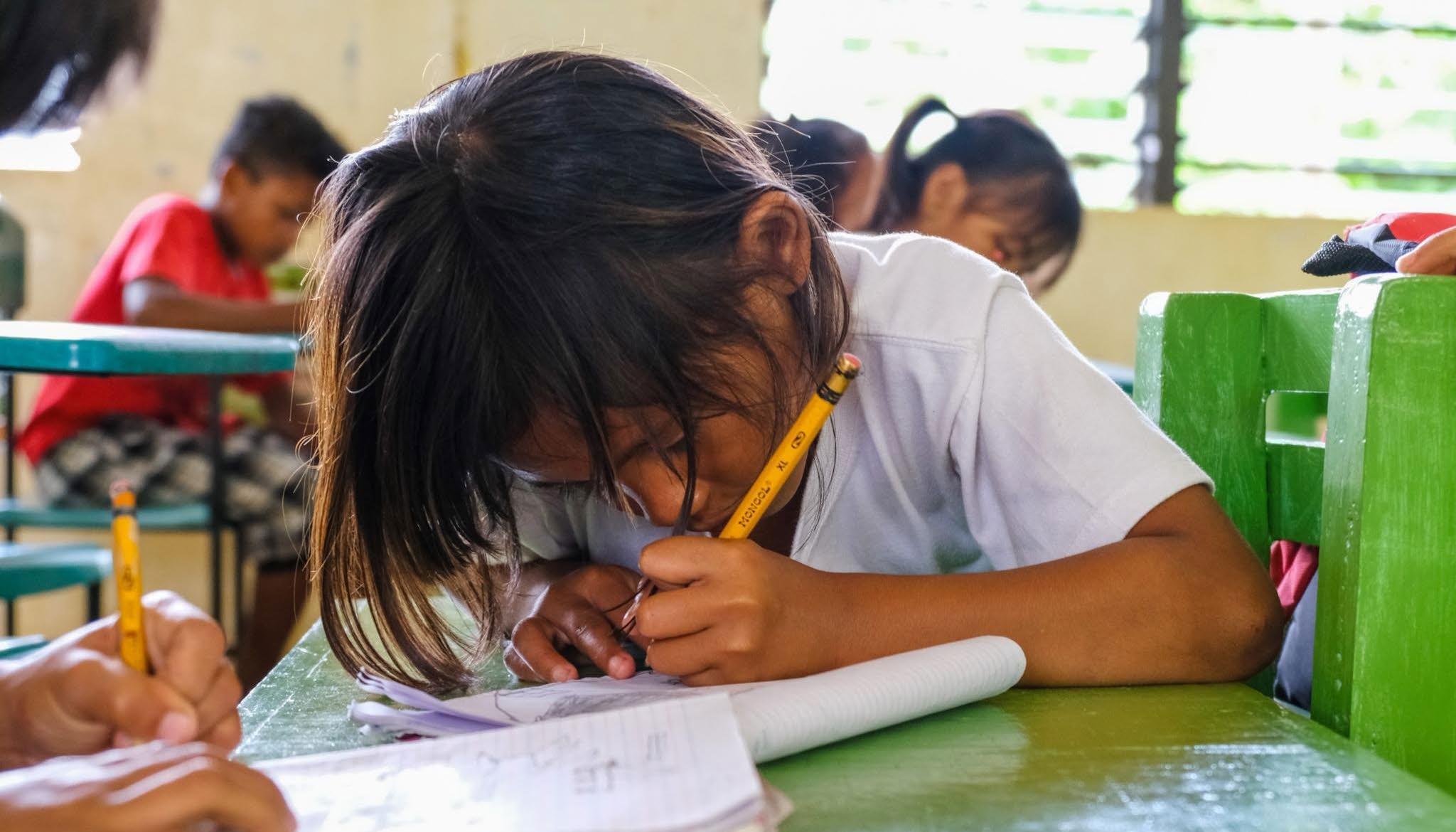


By: JB Parohinog
The Department of Education (DepEd) will administer a pre-test to 15-year-old students in preparation for the 2025 Programme for International Student Assessment (PISA).
The pre-test targets learners from Grade 7 leaners from September 30 to October 11, 2024.
This initiative is part of the department’s efforts to ensure the readiness of Filipino students for the global assessment that measures proficiency in reading, mathematics, and science.
The test will be delivered through the Learning Management System (LMS) or the traditional pen-andpaper format.
Schools are encouraged to use the method most suited to their infrastructure and the needs of their students.
Mariane Lucinencio, a Grade 7 teacher, expressed optimism about the pre-test initiative. “This is a great opportunity for our students to be exposed to international standards early on,” she said.
Lucinencio emphasized that East Central Integrated School uses
laptops to conduct the pre-test.
“Most of our students perform better with technology, if there are students that needs assistance, I’m ready to help,” she added.
From the students’ perspective, Athena Mendoza, a Grade 7 student, shared her thoughts on taking the test.
“It’s a bit nerve-wracking, but I think it’s good for us. It will give us an idea of what to expect,” she remarked.
Mendoza acknowledged that the pre-test would help her, and her peers assess their strengths and areas where they need improvement.
“It’s like a practice run, so we’ll know what we need to work on before the real PISA test in 2025.”
The pre-test is a crucial step toward improving the Philippines’ standing in the international education community, with educators and students eager to demonstrate progress.
The results from this preparatory assessment will provide valuable insights for both DepEd and schools as they plan further interventions leading up to the 2025 PISA.






By: JB Parohinog
DAGUPAN CITY - President Ferdinand R. Marcos Jr. signed the Republic Act (RA) 12028, or the Academic Recovery and Accessible Learning (ARAL) Law, on October 18, 2024.
The law aims to create a national learning intervention program designed to help struggling learners catch up with the required standards for their grade levels.
In relation to the Program for International Student Assessment (PISA), Marcos emphasized the importance of RA 12028 in addressing the learning gaps as he stressed the result of the 2018 PISA and 2022 PISA with no significant difference.
“With the signing of the ARAL Law, we embark on a definite journey to champion the right of every Filipino child to quality education, ensuring as well that it is accessible to all.” he said in his speech.
Under the law, the Department of Education (DepEd) will spearhead the ARAL Program to tap teachers, para-teachers, and pre-service teachers or students enrolled in a teacher degree program.
The program will focus on improving learners’ competencies in main learning areas, including reading and mathematics for Grade 1 to Grade 10 and science for Grade 3 to Grade 10.
Meanwhile, for the Kindergarten learners, the ARAL Program will focus on building foundation skills to strengthen their literacy and numeracy competencies.
To ensure the effectiveness and accessibility of learning, tutorial sessions will be conducted in three flexible delivery modes for all learners to participate based on their needs and circumstances.
On the other hand, East Central Integrated School had already rolled out a comprehensive remediation program to support students struggling with reading, even before President Marcos signed the ARAL Law.
This proactive initiative reflects the school’s commitment to helping learners improve their academic performance and overcome learning challenges.
The ‘Sit Together and Read (STAR)’ program and ‘Reading Buffe’ program to address the increasing number of learners needing extra support in literacy.
Recent school data indicates that of more than 1,200 enrolled students, approximately 10% struggle with reading skills.
Recognizing the urgency of this situation, the school administration has proactively developed a remedial intervention tailored to the specific needs of these learners.
“We have school programs, such as STAR Program where teachers and students can have one-on-one sessions to read and study. We also have a Reading Buffet, where learners are provided to eat. No. It is also a way of helping the learners to have some food before the intervention,” Principal Dr. Reymond N. Villare stated.

By: JB Parohinog
Atroubling 40% increase in teenage pregnancy cases among the 'very young adolescent' demographic (girls ages 15 below) in Dagupan City, Pangasinan has been reported by the Population Commission Office (Popcom).
Out of four regional provinces, Pangasinan recorded 10 live births among teenage moms in 2020, 43 in 2021, and 73 cases in 2022. Dagupan City is the top city in the region with the highest number of cases of early pregnancy.
Ms. Irene A. Oreta, Population Commission Officer of the City of Dagupan, shared the data in an interview.
Oreta said the Popcom Dagupan registered an upward trend in teenage pregnancy among girls aged 15 and below and cited that out of 38 cases in the region in 2020, the number has ballooned to 80 in 2021 and 112 in 2022.
In sharp contrast, the number of cases of pregnancy (live birth) from women aged 15 to 19 has decreased.
In 2020, there were 4,291, down to 3,712 in 2021, and 3,754 live births in 2022 from women aged 15 to 19.
The PopCom Dagupan attributes the increas-
ing number of teenage pregnancies to easily accessible data, internet, and social media content, particularly through adult websites.
From the school’s perspective, East Central Integrated School (ECIS) is enhancing its efforts to promote gender awareness through activities that emphasize the significance of Gender and Development (GAD).
This initiative responds to the alarming 40% increase in teenage pregnancies reported in Dagupan City, as noted by the Population Commission Office (PopCom).
ECIS incorporates GAD principles into school competitions and activities, highlighting the importance of gender equality and responsible decision-making among students.
These efforts align with the Department of Education’s DO 32 s. 2017 – the Gender-Responsive Basic Education Policy.
This policy mandates schools to integrate gender-responsiveness into their education system, reflecting the 1987 Philippine Constitution and related laws.
By following these guidelines, ECIS promotes gender sensitivity in its activities, helping students understand the implications of issues like teenage pregnancy.



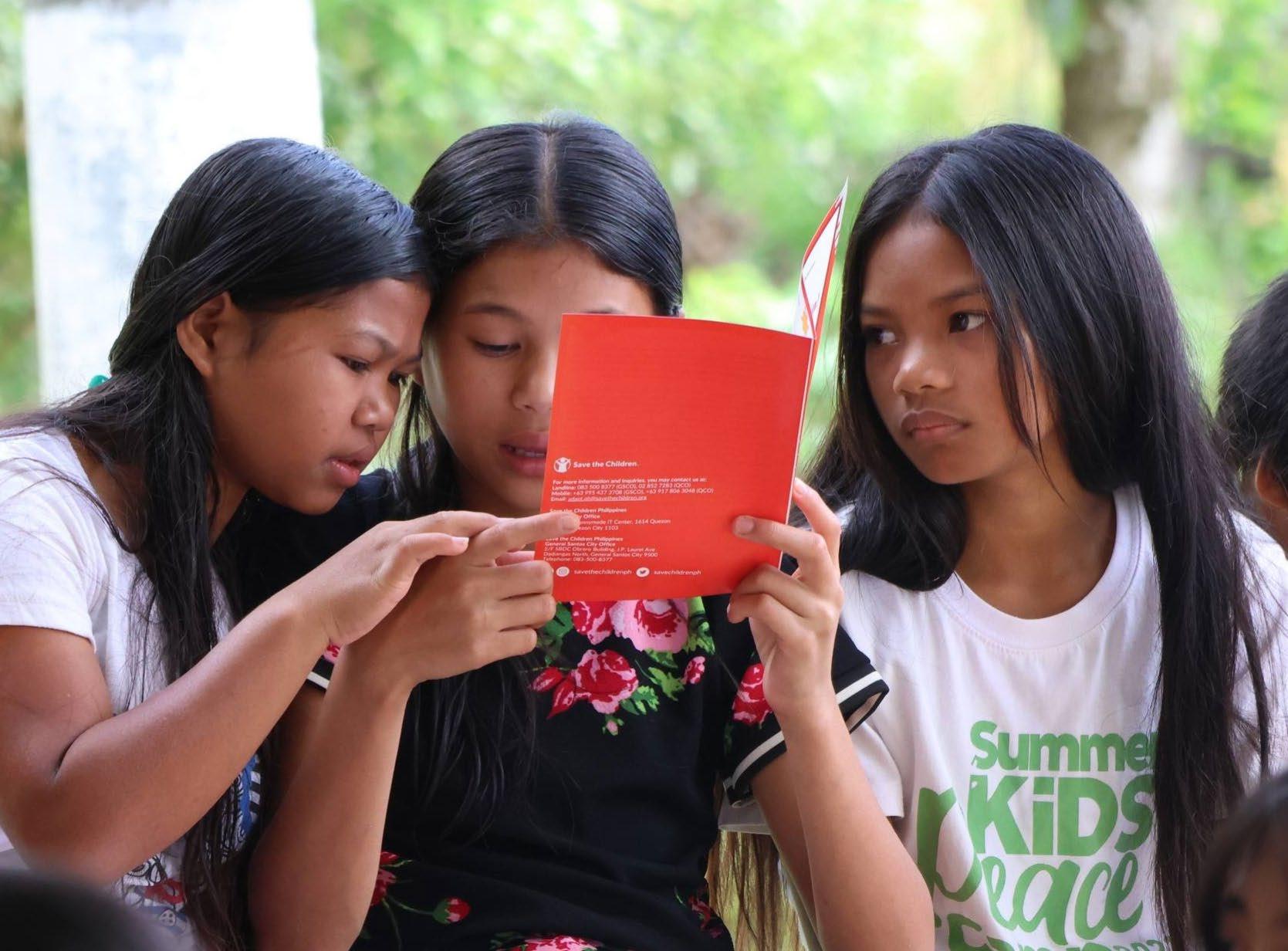


By: JB Parohinog
The first-year implementation of the MATATAG Curriculum, introduced by Vice President Sara Duterte during her time at the Department of Education (DepEd), has stirred mixed reactions among parents, students, and teachers from East Central Integrated School.
To address education gaps and enhance language, mathematics, and literacy learning, the new curriculum has been implemented in kindergarten, Grade 1, Grade 4, and Grade 7 this school year.
New DepEd Secretary Sonny Angara confirmed that the MATATAG Curriculum is under review to address feedback gathered from teachers and school administrators.
“We have issued a department order setting the curriculum, but we have also received many comments. We will be sensitive to these comments,” Angara said.
The MATATAG Curriculum emphasizes foundational subjects, including nationalism and good manners, through two new programs, the National Mathematics Program (NMP) and the National Reading Program (NRP).
However, challenges in implementing the curriculum have emerged, with teachers noting the compressed teaching schedules
and the volume of material to be covered within short periods.
“Walang books pero may worksheet. Kung sa discussion of the lesson, kulang and 45 minutes,” said Ms. Liezel Martinez, Grade 7 teacher.
On the other hand, many teachers have supported more comprehensive consultations involving key stakeholders, including educators, to enhance the curriculum and ensure it meets everyone’s needs.
“Ang NMP and NRP programs ay maganda para mas ma-ehance ang teaching and learning ng teacher at student,” another teacher remarked.
Despite its challenges, the first-year implementation of the MATATAG Curriculum marks an important step to improving the Philippine education system.
While critical of certain aspects, East Central Integrated School stakeholders also expressed hope the new curriculum will lead to a meaningful impact.
As the curriculum rolls out to additional grade levels next school year, the DepEd remains committed to adapting based on science-based data and feedback from those at the forefront of its implementation—the teachers.

F
By: Christian Rico
orty-three students from Grade 7 to Grade 12, including both newcomers and seasoned members, gathered for the two-day Journalism Skills Training (JST) organized by Blazing Beacon, the official school publication of ECIS, on October 9-10, 2024.
The event aimed to rekindle enthusiasm for onsite journalism and sharpen the skills of aspiring writers as they prepare for future competitions, with an eye on the National Schools Press Conference (NSPC) 2025.
The training began with Mr. Joshua Bileg, the school paper adviser, emphasized the need for new campus journalists to replace graduating writers and lead the publication into the future.
“This year, we want to recalibrate the minds of our young journalists—not just to win, but to become globally competitive,” he said.
The JST was structured to train and recruit the next generation of Blazing Beacon writers, inspiring them to take on roles of leadership and creativity in campus journalism.
Following an orientation, aspiring journalists faced challenging tasks in four key areas: writing a news story, an editorial article, a feature piece, and a sports report.
Based on their performance, School Paper Advisers selected those who showed great potential,

By: Clarissa Barozzo
In line with the Department of Education’s (DepEd) vision to improve the country’s education quality, teachers at East Central Integrated School have implemented the Language Enhancement through Reading Assessment (LETRA) program.
English and Filipino teachers conducted a reading assessment during the previous school year, revealing that 20% of students from Grades 7 to 12 fall under the frustration level in reading.
This finding prompted a collaborative effort among teachers to create effective strategies to address the issue and support struggling readers.
To address this challenge, Senior High School (SHS) Reading Coordinator Ma’am Mylene C. Boquiren called for an urgent meeting to explore strategies for improving students’ reading skills.
“Our goal is to progressively eradicate illiteracy
among our students and provide them with supplementary reading materials,” said Ma’am Boquiren.
Despite the full teaching loads, teachers and advisers are putting in extra effort to support students facing reading difficulties.
As part of this initiative, books were distributed, and online materials were used to assist slow readers, offering interactive tools to enhance their skills.
Students identified as poor or struggling readers are under strict observation to monitor progress and ensure the effectiveness of the intervention.
Through these targeted interventions and collaborative efforts, East Central Integrated School aims to foster a supportive learning environment that empowers students to improve their reading abilities and achieve academic success.

By: Greg Ryan So
To safeguard the health of millions of students, the Department of Education (DepEd) and the Department of Health (DOH) officially launched the School-Based Immunization (SBI) program, now called “Bakuna Eskwela” on October 7, 2024.
The program is designed to protect children from vaccinepreventable diseases (VPDs).
After a four-year suspension due to the COVID-19 pandemic, the Bakuna Eskwela program marks a major shift back to school-based immunizations, focusing on the vaccination of students against diseases like measles, rubella, tetanus, diphtheria, and human papillomavirus (HPV).
The program will run nationwide from October to November 2024 in selected public schools.
“School-based immunization strengthens our agenda, particularly in ensuring learners’ physical and mental well-being,” Education Secretary Angara said during the launch.
He emphasized that the immunization effort is key to providing students with a learning environment free from health burdens.
with the most outstanding among them earning editorial roles.
JB Parohinog, a Grade 12 HUMSS student, was appointed as the new Editor-in-Chief, ready to lead the young journalists toward excellence.
“We want to be prepared for campus journalism and aim to secure the number one spot in the Division Schools Press Conference (DSPC),” JB stated, underscoring their collective aspiration to continue ECIS’s legacy of journalistic success.
In the Regional Schools Press Conference 2023, JB Parohinog ranked as 3rd place in the news writing - English Category.
“I really want to experience being part of the NSPC qualifier and represent Region 1 in the news writing competition,” JB expressed excitement.
Reflecting on the aspirations of the students, Mr. Bileg highlighted the importance of resilience and adaptability in journalism.
“Our goal is to prepare these young journalists not only to excel but to make an impact. We want them to stand out at the DSPC, RSPC, and NSPC because they bring something unique—insight, integrity, and talent,” he said.
Both students and teachers are focused on honing their craft to qualify for and excel at NSPC 2025, bringing pride to their school and showcasing their talents nationally.
Angara noted that this initiative aligns with DepEd’s five-point agenda to improve educational outcomes, following the directives set by President Ferdinand Marcos Jr.
The program aims to immunize 3.8 million Grade 1 and Grade 7 students with MR (measles and rubella) and Td (tetanus and diphtheria) vaccines, and provide HPV vaccines to nearly 974,000 Grade 4 female students to protect them against cervical cancer.
Strong Support from ECIS
East Central Integrated School – Grade 7 teacher
Christian Barrozo, expressed his support for the program, citing how crucial it is to have healthy students in the classroom.
“When students are healthy, they can focus more on their studies. It’s reassuring for us as teachers to know that they are protected from these dangerous diseases,” he said.
From the student’s viewpoint, Kim Gonzales, a Grade 7 student, shared her excitement about the program.
“I’m glad we are getting vaccines in school. It helps us stay healthy, and I don’t have to worry about getting sick and missing class,” she said.
Also, parents like Raul Gonzales, are equally supportive. “As a parent, it’s
comforting to know that my child is protected from diseases like measles and tetanus.
It’s a relief that the program has returned to schools, where it’s more convenient for students and parents alike,” he shared.
Program Budget and Nationwide Rollout
The DOH and DepEd aim to utilize a budget of P853 million for Bakuna Eskwela, which will continue in public schools nationwide until November 2024.
School-based immunization (SBI) had been halted due to mobility restrictions during the pandemic, but now, with faceto-face classes fully resumed, the program has returned to full capacity.
This revival is supported by DOH Department Memorandum 2024-0250 and DepEd Memorandum 2024-03-06789 issuance.
The return of Bakuna Eskwela signifies a concerted effort to protect students from preventable diseases and ensure their overall wellbeing as they continue their education.
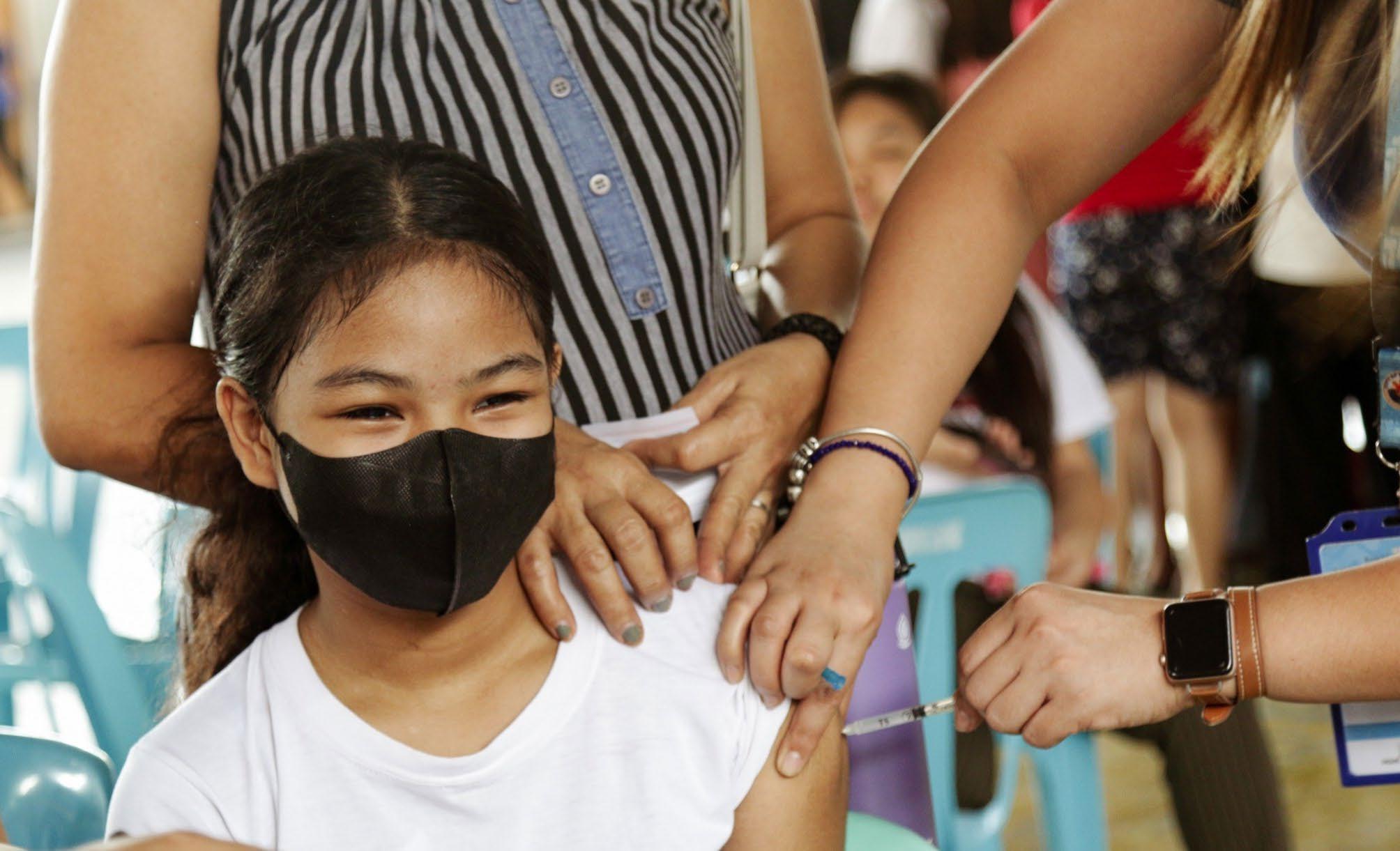


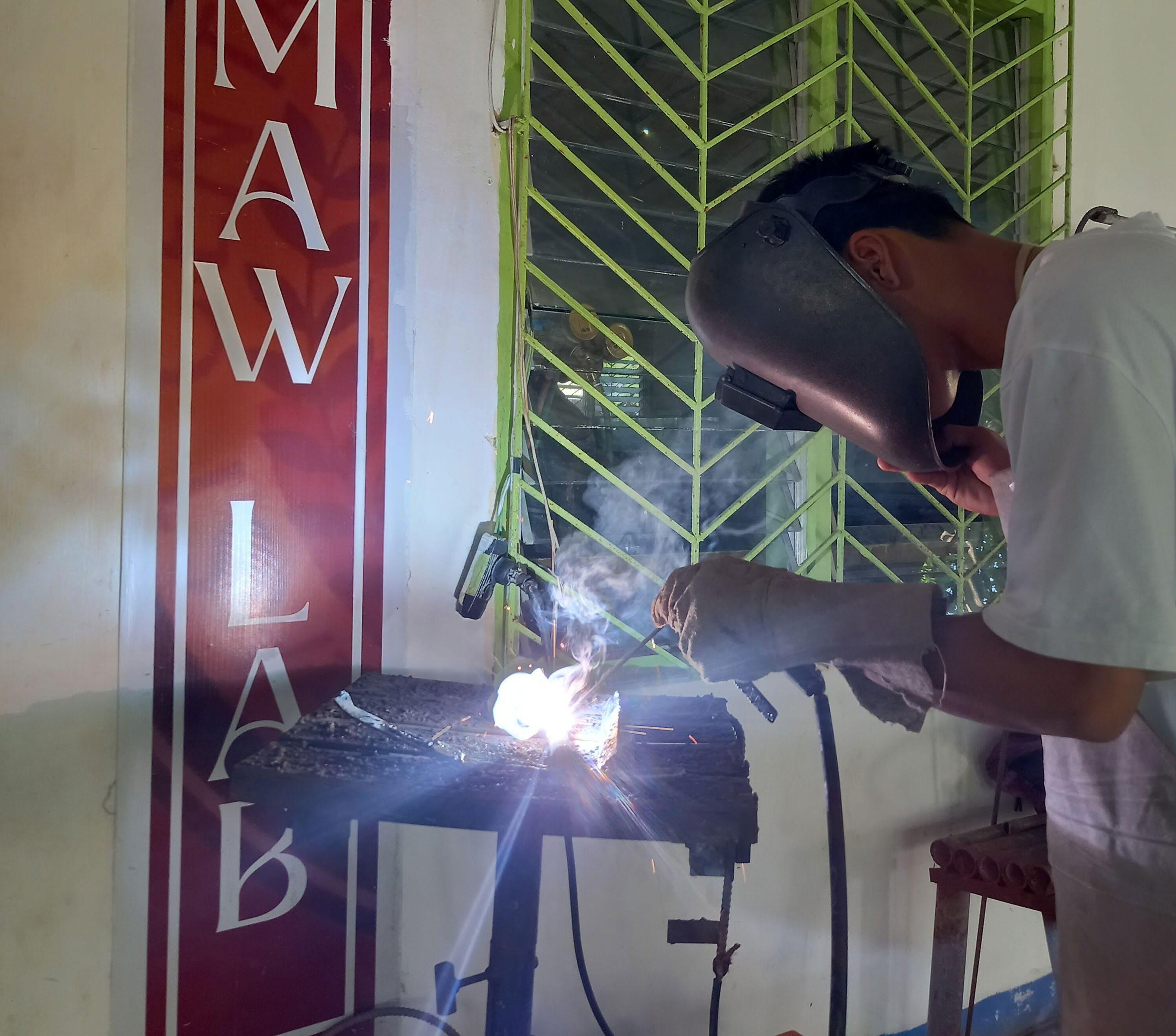


By: JB Parohinog
To impact the education system, East Central Integrated School (ECIS) is emphasizing hands-on experiences and practical learning for the benefit of students, providing them with opportunities to engage directly with skills and tasks that will be highly valuable in the workforce.
This shift is particularly significant for Technical-Vocational students studying courses like welding and caregiving.
The school’s Work Immersion Coordinator, Sir Mark Christopher Braganza, explained that this new focus aims to bridge the gap between theory and practice.
“Employers look for graduates who can contribute immediately to their company.
With our new focus, we want to make sure our students don’t just pass exams—they excel in real, practical situations,” he said.
Students have been putting more effort into hands-on learning.
Grade 12 student Vanie Mc Vea, currently taking Shielded Metal Arc Welding (SMAW), explained that he used to feel nervous about written tests as they didn’t reflect his practical skills.
“With the focus on practical experience, I can
now show my real skills, and I’m more confident about getting a job after I graduate,” Mc Vea said.
The school has also encouraged partnerships with local industries, allowing students to engage in internships and on-thejob training.
These opportunities allow learners to experience working in their chosen field while building connections with potential employers.
School Principal, Dr. Reymond N. Villare, emphasized that a skill-based approach is crucial to the development of the Tech-Voc students.
“When we talk about Tech-Voc programs, it is necessary for these students to learn the skills and they can only learn the skills if they are exposed to what is really being done in that particular program,” he said.
The approach to technical-vocational education should not only be about passing exams but also gaining the skills, confidence, and experience that students need to thrive in their careers and contribute meaningfully to society.
With this paradigm shift, the school is setting a new standard for what quality education should look like—hands-on, practical, and, most importantly, student-centered.
“When we talk about Tech-Voc programs, it is necessary for these students to learn the skills and they can only learn the skills if they are exposed to what is really being done in that particular program.
- Dr. Reymond N. Villare
(School Principal)
SHS studes population down by 4.55%

By: Greg Ryan So
East Central Integrated School's Senior High School (SHS) student population dropped by approximately 4.55% from the 2023-2024 school year to the 2024-2025 school year.
According to Ms. Rica Mae G. Taminaya, Teacher II from the SHS Department, one reason for this was the obvious number of Grade 10 learners at ECIS who opted to transfer to various schools to attain scholarship programs.
“Another was they want to try and study in a different environment. Since some have been going at this school for a considerable amount of time, they now preferred letting loose and exploring,” she added. Accordingly, former bona fide Grade 10 learners of ECIS have chosen to enroll in universities, such as PHINMA - University of Pangasinan
(UPang) and Lyceum-Northwestern University (LNU) sooner to adapt to the stress that comes with adjusting to the nearing “college life.”
To boost the enrollment for the next school year, teachers at Senior High School Department will strengthen the career guidance for the incoming Grade 10 students.
Senior High School Coordinator, Mr. Mark Christopher Braganza expressed his idea, “We really need to strengthen the career guidance. Possible ang opening ng new strand na gusto nila thru carreer guidance survey, “he said. Through the enhanced strategy, the SHS Department is optimistic and expects a full 100% enrollment of Grade 10 graduates into Grade 11 for the next school.

E
By: JB Parohinog
ast Central Integrated School (ECIS) recently emphasized its commitment to inclusivity and diversity by advocating for the acceptance and support of learners and teachers who are members of the LGBTQIA+ community.
The initiative aims to foster a welcoming environment where diverse sexual orientations and gender identities are respected within the school community.
“This movement helped promote awareness and foster open dialogue on inclusivity and equality,” said Greg So, SSLG President.
In 2010, Dagupan City passed the “Anti-Discrimination Ordinance: Further Promoting Gender and Equality in the City of Dagupan,” which aims to prevent discrimination based on sexual orientation.
This ordinance underscores the city’s dedication to upholding the dignity and equality of all individuals.
The Department of Education has implemented its Gender and Responsive Basic Education Policy (DepEd Order 32, s. 2017), ensuring that LGBTQIA+ students and teachers can express themselves freely without fear of discrimination.
These measures and ECIS’s advocacy continue to promote an inclusive and supportive learning environment.


BANGUS CRISIS, from page 1
Jovan, a Grade 7 student, echoed his father’s concerns. “Minsan kasama ako nila ako na nanghuhuli ng isa. Hindi na ako nakakapasok dahil alam ko na problem ni Papa ang gastusin. Sana mabawi nila ang gastos nila,” Jovan said.
The impact of the declining prices has left many families, including the Reyes family, in a precarious position.
The economic strain has meant that even basic needs are becoming difficult to afford, affecting not only their livelihood but also the education and well-being of their children.
Oversupply Adding to Woes
The main reason behind the declining prices is an oversupply of bangus from various coastal towns in Pangasinan, worsened by bangus growers from
other provinces who bring their fish to Pangasinan to capitalize on the region’s well-known bangus. This has led to a glut in supply, pushing prices down even further.
“The market is flooded,” said Florence Sarmiento, an aquaculture operator from Anda town.
“In Anda alone, we have between 4,000 to 5,000 fish cages, and there are even more in the southern provinces. If we could control the number of growers, we might be able to stabilize prices a little.”
The struggles of bangus growers like Sibayan and local families, including fisherfolk like Jolo Reyes, highlight their hope for large profits this ‘Ber’ month and their desire for strict regulation of unscrupulous traders to achieve better profit.


By: JB Parohinog
The appointment of Senator Sonny Angara as the new Secretary of the Department of Education (DepEd) received a positive outlook among the parents, teachers, and students of East Central Integrated School despite the challenges faced by the department in solving the learning gaps in the education system.
The survey, which involved 500 respondents, found that 76% of parents, 82% of students, and 90% of teachers expressed approval of Angara’s appointment, citing optimism over his proposed education reforms.
Survey Results Show Diverse Opinions
Seventy-six percent of parents expressed optimism about Angara’s appointment, citing his background in legislation and previous advocacy for increased education funding as key reasons.
“Dapat ang nasa position bilang DepEd Secretary ay may alam sa education system tulad niya pero tignan natin,” shared Jane Dela Cruz, a mother of two elementary students.
A smaller group of parents, 24%, raised concerns over whether his plans could be
implemented effectively, worrying about the practical challenges of large-scale education reforms.
Similarly, students have high hopes with 80% expressing support for Angara’s proposed programs, which include enhancing digital learning resources, improving school facilities, and solving learning gaps.
Grade 12 student Gemmarie Benghit shared, “These reforms are important to all the students. I can learn and study more.”
In contrast, 20% of the students prefer Vice President Sarah Duterte as the DepEd secretary.
Teachers were the most optimistic group.
According to the survey, 90% of the teachers supported Angara’s plans, particularly his proposal to increase teachers’ salaries and reduce administrative workloads.
“We need someone who genuinely understands our situation,” said Mrs. Filipina Calaunan, a Grade 11 teacher.
However, the 10% of the teachers emphasized the importance of action over verbal promise.
Angara’s Plans for DepEd
DepEd Secretary Angara outlined several key initiatives to address the most pressing
issues within the education system.
These include increasing teachers’ salaries by 30%, modernizing school facilities, and expanding digital resources to bridge the learning gap. Sec. Angara also emphasized the importance of curriculum reform, focusing on making the K-12 program more relevant to the needs of both students and the Teachers.
The Deped Secretary will be improving the quality of education not just through infrastructure but also by investing in teachers’ professional development.
According to DepEd data, the budget allocated for these initiatives will be increased by 20% over the next two years, reflecting Angara’s commitment to educational transformation.
While there is hope for change, particularly among students and parents, there are concerns about the feasibility of implementing such ambitious reforms within the existing system.
The coming months will determine whether Angara can translate his vision into tangible improvements for the country’s educational system.

By: Greg Ryan So
The Boy Scouts of the Philippines (BSP) announced the winners of the 2024 Search for the Ten Outstanding Boy Scouts (TOBS) of the Philippines on October 18 in Cebu City.
Among those recognized was Laurence Kier M. Viray, a Grade 11-STEM student from East Central Integrated School and Senior Crew Leader of Outfit 45, representing the Ilocos Region.
Viray’s award highlights his dedication to leadership, academic excellence, and community service—qualities that define this prestigious recognition, which has become one of the most anticipated annual events organized by the Boy Scouts of the Philippines.
The TOBS program, held in partnership with the Ten Outstanding Boy Scouts of the Philippines Association, selects ten scouts from among regional finalists nationwide, acknowledging their exceptional scouting values and contributions to society.
This year, Viray stood out among 26 finalists, representing the BSP’s approximately two million members nationwide.
Speaking on his achievement, Viray emphasized the deeper meaning of being a Boy Scout: “It’s not just about the ranks or the accomplishments but being a light of inspiration
in our community.”
His passion for inspiring others and making a positive difference was central to his journey.
As a Regional Scout Representative of the Ilocos Region, he led various community projects and maintained strong academic performance, earning him recognition as one of the country’s outstanding young leaders.
Viray’s grandmother, Ma’am Edwina Orbe, was proud of her grandson’s achievements.
“We’ve always known Laurence had a heart for service, even as a young boy. He’s always been eager to help others, and seeing him recognized like this only confirms what we’ve always believed—that he’s destined to make a difference,” she shared.
Viray’s selection into the TOBS reflects the spirit of scouting that aims to develop responsible, community-minded youth.
Ma'am Edwina added, "This award is a reminder of how Scouting shapes lives. It's not just about medals or honors— it’s about building character."
The TOBS awardees, including Viray, embody the mission of the Boy Scouts of the Philippines to nurture competent, conscientious, and community-driven leaders.





By: JB Parohinog
In a significant boost for students in the region, 1,524 Grade 11 and Grade 12 students from Dagupan, Mangaldan, and San Fabian received ₱3,000 each through the 2024 AKAPTulong Eskwela Program, launched by President Ferdinand Marcos Jr.
The cash assistance to students took place at the Dagupan City Astrodome last August 30, 2024.
The AKAP (Ayuda sa Kapos ang Kita Program) aims to provide financial assistance to students, easing the burden of educational expenses for families.
Congressman Toff de Venecia led the distribution with the Department of Social Welfare and Development (DSWD) support.
“Let’s give thanks first and foremost to our beloved President Bongbong Marcos Jr. for doing everything he can to help
our parents and students,” Congressman Toff stated during the event.
One of the students benefiting from the program, Jude Santillan from East Central Integrated School, expressed his gratitude, saying, “Ang saya ko dahil may isang buwan na budget na ako.”
Jude added that the financial aid is a great motivator for students. “Motivated ako mag-aral dahil may baon na ako. May pambili na rin ng school supplies,” he said.
Congressman Christopher de Venecia and House Speaker Martin Romualdez championed the initiative, emphasizing the need to extend aid to improve the lives of Filipinos, especially the youth.
The program has been met with enthusiasm from students and parents alike, fostering hope and optimism in the community for a brighter future through education.

By: Johnelle Baniqued
I n a display of compassion and resilience, the Scouts of East Central Integrated School spearheaded a vital food relief initiative for flood-stricken communities in Barangays Herrero and Mayombo on September 7.
Scout Laurence Kier M. Viray led the initiative as part of the T.A.B.A.N.G H.U.B project (“Together Assisting in Bringing Aid, Nourishment, and Generosity for Humanity Upliftment and Betterment”), aimed at bringing relief and hope to vulnerable typhoon-affected Dagupenous.
The scouts demonstrated incredible resilience and dedication, navigating waterlogged streets and braving unsafe conditions to bring meals and muchneeded relief to the affected residents.
Scout actions were a clear testament to their commitment to serving the
community when it needed them the most.
Under the guidance of scout adviser, Anacencio L. Aguilar, the young scouts embraced the challenges posed by the flooding and demonstrated their determination to help those in need.
School administration support, Mr. Balbino D. Nicolas Jr. HT III and School
Principal Dr. Reymond N. Villare, also played a major role in the project’s success and invaluable assistance.
The food relief initiative carried out under the T.A.B.A.N.G H.U.B project is yet another example of the scouts’ dedication to community service.
It highlights the ability to rise above challenges, extend support to those who need it most, and serve as role models of resilience and compassion in their community.

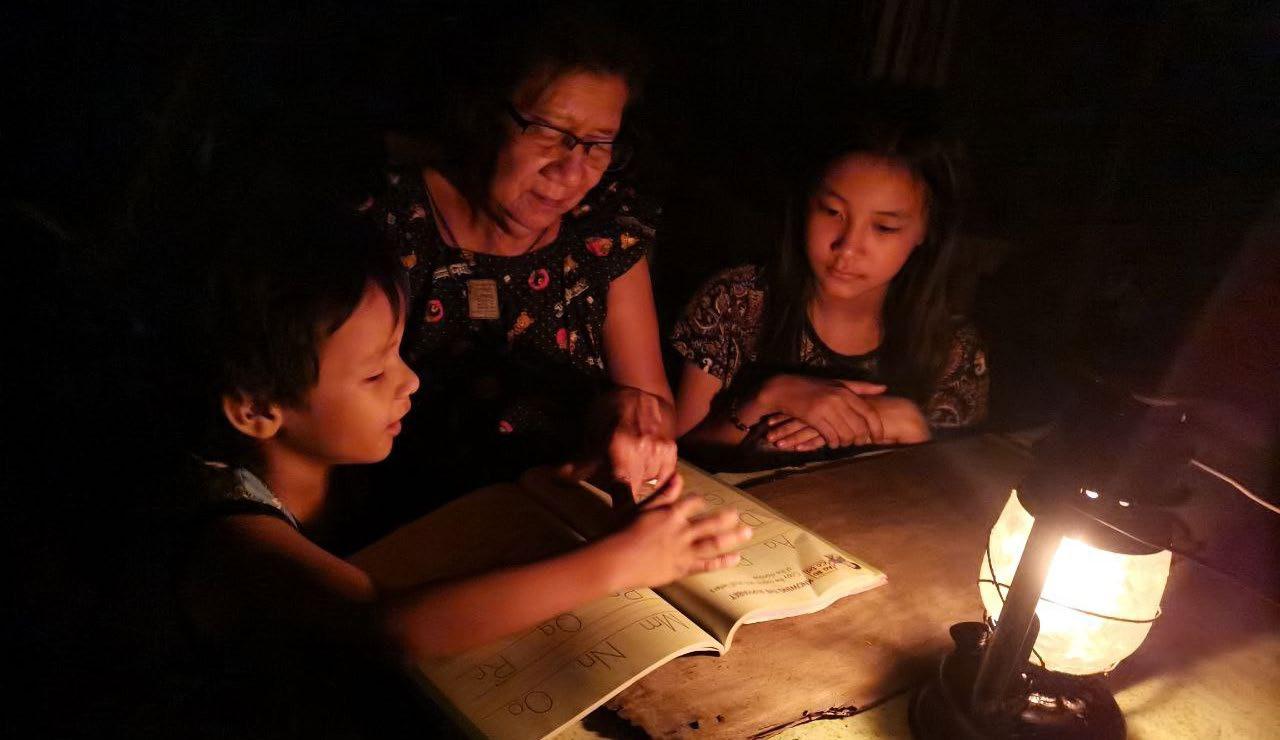
GRANDMOTHER’S LOVE.
Lourders Junatas, a retired teacher, supported the strengthen home-school partnership by teaching her grandchildren, Ompong and Daniela, at home.


By: JB Parohinog
The Parent Teachers Association (PTA) has strengthened its collaboration with schools to ensure a stronger home-school partnership, PTA President Rodel Ramos shared in an interview with The Blazers on October 8.
The PTA's plans include holding regular consultative meetings with the School Principal at least three times a month to address learning gaps and discuss the ongoing challenges and issues within the school.
"The home and school should work together for one goal—the betterment of the students," Ramos said, emphasizing that a shared vision between parents and educators is key to fostering a thriving partnership.
He highlighted the importance of parental involvement in school activities, citing it as a true example of a productive home-school relationship.
Ramos underscored that a strong home-school partnership creates a healthy environment among parents, students, and school personnel.
"We will all be motivated to go to school, do assignments at home, and treat school as our second home," he stressed.
Ramos disclosed that the PTA has projects to help students and parents have more time for academic pursuits.
"When parents take an active role in their children's education, everyone benefits—the students, the parents, and the school as a whole. It's all about creating a space where everyone feels motivated and supported," Ramos concluded.
From the teacher’s perspective, Head Teacher III, Sir Roan Fernandez, expressed his support, stating, "The PTA's plans are commendable, especially in addressing learning gaps. Truly, earning must begin at home."
The PTA's efforts to build stronger home-school connections are a step forward in fostering a collaborative community that values education.

By: JB Parohinog
The City Government of Dagupan has reinforced its commitment to combat domestic and family violence through a new partnership with the Department of Justice (DOJ), the Philippine National Police (PNP) Dagupan, the Dagupan Prosecutor’s Office, and the Region 1 Medical Center (R1MC).
A Memorandum of Agreement (MOA) was signed at the Francisco Q. Duque Hall, R1MC, aimed at enhancing support for victims of abuse, including cases of sexual violence, violence against minors, and psychological and emotional abuse.
"We have come together to form a vital partnership aimed at addressing and support-
ing victims," said Dagupan City Mayor Belen T. Fernandez, emphasizing the collaboration’s role in improving the city’s response to these critical issues. She also highlighted the presence of the city's Women’s Center, which provides comprehensive support to victims.
The MOA outlines a system for faster and more efficient handling of abuse cases. This includes the introduction of a "fast lane" at R1MC for quicker issuance of medico-legal certificates, which are crucial for court proceedings. Dr. Joseph Roland O. Mejia, Medical Center Chief of R1MC, remarked, "This partnership will expedite justice for victims, particularly through prompt medical and legal support."
City Prosecutor Ma. Victoria D. Cabrera described the MOA as a "covenant" that would ensure more accessible support for victims,
especially those from underprivileged sectors. "This agreement is a commitment to be responsive to the needs of the victims, ensuring they can access the support they require more efficiently," she stated.
PLTCOL Brendon Palisoc of PNP Dagupan noted that delays in securing essential documents, such as medico-legal certificates, have been a significant issue for officers filing cases. "With this MOA in place, such delays will be a thing of the past," he assured.
The MOA is expected to streamline interventions, providing a seamless system of support and justice for victims of domestic and family violence in Dagupan City. Also present at the signing were DOJ Regional Prosecutor Christian Paul L. Ulpindo and several key officials from R1MC.

I
By: JB Parohinog
n the bustling streets of Dagupan, the student mode of transportation is rapidly gaining popularity, offering convenience, savings, and a greener alternative to traditional vehicles.
The electric bike, or e-bike, is eco-friendly, offering comfort to the community and students alike.
E-bikes have become increasingly popular in Dagupan City since 2014.
With its compact size and ease of driving, e-bikes are proving to be an efficient and effective alternative to traditional motorcycles and tricycles.
One of the best advantages of e-bikes is the convenience of its users.
“This makes it an ideal choice for students and parents to commute to and from the school,” said Mr. June Gutierrez, assigned traffic enforcer.
“With an e-bike, they [students and parents] can easily navigate through traffic, reducing travel time and allowing them to get to their classes on time,” he added. Moreover, e-bikes offer significant savings for students and parents.
“E-bikes run by electricity, which is less expensive than gasoline today, and it requires less maintenance,” said Mr. Robert Martiner, a grandfather.
“This makes them a cost-effective choice for students and families on a budget since inflation is increasing,” he added.
The rise of e-bikes in Dagupan City is not just a trend but a reflection of a broader shift towards sustainable and affordable transportation.
As the new king of the road, the e-bike transforms how people travel and contributes to a greener and more sustainable city.


By: Christian Rico
The advent of technology has made libraries farther from the heart of the youth, with a preference now for gadgets.
However, East Central Integrated School is not letting its books remain untapped. It converts extra space into a reading haven and distributes new books to encourage learners to love reading.
Language teachers worked together to transform vacant isles of the school into colorful and inspiring corners, where teachers and students meet to start reading sessions after class hours.
“Reading is essential; however, today’s generation is not born readers. So, we need to think of ways to encourage them to read and love it eventually,” said Mr. Kenneth Llamas, an English teacher.
Teachers are happy with the acceptance of the parents and guardians in the initiatives. Mr. Llamas expressed that language teachers are glad to extend help as part of the profession.
Right after school hours, learners from grade 7 to grade 12 attend reading enhancement and remedial sessions while other students visit the corner to read academic books.

By: Christian Rico
Despite easing inflation to 1.9 percent in September, parents and students of East Central Integrated School in Dagupan City continue to feel the effects of rising prices.
Lourdes Villamil, a parent at East Central Integrated School, expressed concern about how the fluctuating inflation impacts her family's daily expenses.
“Kahit na bumababa ang inflation, ramdam pa rin namin ang taas ng presyo sa mga pangunahing bilihin,” Villamil shared. She highlighted that while some food prices have slightly decreased, essentials like rice and meat remain expensive.
Data from the Philippine Statistics Authority (PSA) indicate that the September inflation rate is the lowest since May 2020.
Government attributed the downtrend to slower increases in food and non-alcoholic beverages, with rice inflation easing to 5.7 percent from 14.7 percent in August. However, many like Villamil still find adjusting their budgets challenging.
The National Economic and Development Authority (NEDA) assured that the government is committed
to stabilizing prices and boosting consumer confidence.
Parents in Dagupan, such as Villamil, hope for more immediate and concrete measures to lessen the burden of daily living expenses.
“We hope that the government continues its efforts to keep food prices stable, lalo na ngayong papalapit na ang Pasko. We need assurance that our families can still afford to meet our essential needs," she added.
In response to this economic challenge, East Central Integrated School has taken the initiative to maintain affordable prices in the school canteen, ensuring that students can access nutritious meals without straining their allowance.
Head Teacher, Sir Balbino Nicolas emphasized, "We understand the challenges faced by many families, so keeping our canteen prices reasonable is part of our support for the community."
While the recent drop in inflation provides a glimmer of hope, many parents remain cautious and vigilant about their spending in the face of ongoing economic challenges.


Editor-in-Chief: JB Parohinog
Associate Editor: Greg Ryan So
Managing Editor: Cip Andrie Alarcio
News
Editors: Christian Rico; Johnelle Baniqued; Clarissa Barrozo
Feature Editors: Gemmarie Benghit
Brent Lu
Sports Editor: Lebronne Sison; Christ Distor; MJ Lopez
Science and Technology
Editors: Dannica De Vera
Lawrence Viray
Editor Cartoonist: Kent Macaraeg
Advisers: Joshua Bileg
Kenneth Carl Llamas
Aubrey Gemino
School Principal IV: Dr. Reymond N. Villare
Disclaimer:
The views and opinions expressed by The Blazing Beacon editors and staffers do not necessarily reflect the views and opinion of the school. Every content of this paper is not intended to malign any individual, ethnic group, religion, organization, or company.
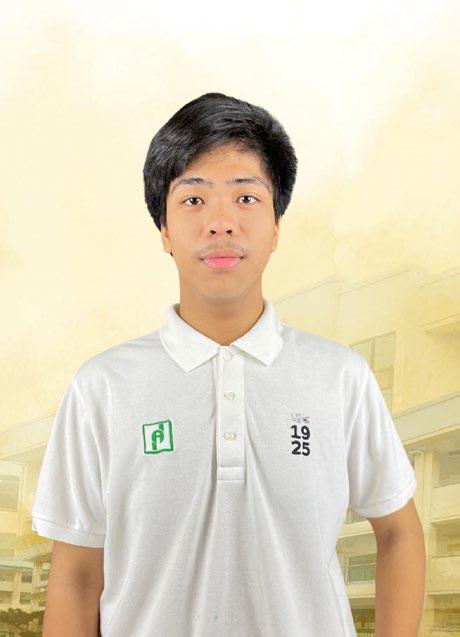
Cip Andrie Alarcio Managing Editor
For the past years, election became a circus-like where it is common for celebrities and online influences in the Philippines to present their malicious make-ups or their red noses—into the political matter, even some lacks magic trick needed for law and governance.
While fame may help them for a crowd sensation, they made the election a celebrity birthday party that raises my concerns about whether these star-stocked candidates truly have the skills and qualifications to lead the country. Politics is not a circus platform; It requires us to have a deep understanding in terms of governance, economic, and societal understanding. Without this principle revolving around them, our leaders may struggle to make wise choice that could impact the quality of our life here in the Philippines.
When so-called influencers run for office, their popularity often becomes their investment for their candidacy, turning the election into a circus show where best-actor/ best-actress award became the basis, not their credentials and immediately become a so-called leader.
Voters sometimes choose candidates based on their entertainment and media-vision rather than considering the real vision, plans, or dedication to public service. This weakens the image of our government, as it favors those with a big fan base and a hideous attitude over those with genuine leadership qualities and platforms, the attorneys.
Furthermore, these "political clowns" that lack background in law and governance can be influenced by corrupt politicians that can be an advantage in the government.
Without a vocabulary in political principles and a clear understanding of how government should work, they risk our beloved country for they will become puppets and manipulated by their own hidden interest. This not only puts the dignity of their leadership into a vengeful plan but also turns the policies they will implement into nothing more than balloon animals—twisted to a malicious act.
In the end, for me, leadership is more than just a best-actor/ best-actress award. It's about embodying the right knowledge, experience, and a genuine desire to provide us with real public service. As citizens, we must take off our vague glasses and look beyond the make-ups of the celebrities or their fake platforms.
Our vote is not a ticket to attend a circus play; it's a serious for us that it is our responsibility that our choice should go to candidates with true skills, dedication, and the catalyst of change pushing the nation forward. Let's make sure that in 2025, we choose leaders who are more than just clowns when facing us or shaking hands with us.
> MAIN EDITORIAL
In the years of martial law under Ferdinand Marcos, Sr., Philippine journalism faced one of its darkest periods. Censorship strangled the press, forcing journalists into submission under the threat of imprisonment, exile, or worse. Information was filtered, limited to narratives favorable to the administration, stifling voices that dared to speak the truth. Laws criminalized criticism, and journalists who defied them often paid a steep price.
This era left deep scars on the nation, depriving the people of objective, truthful information—a foundational need in any democratic society.
Today, the Philippines is free from the overt tyranny of a dictator, yet the specter of that era lingers, haunting our media landscape in subtler, more insidious ways. While no law expressly bans criticism of the government, various forms of pressure exist that undermine press freedom.
Reports from the Committee to Protect Journalists (CPJ) have documented cases of harassment and intimidation of Filipino journalists, especially those covering topics of corruption or abuse of power.
Newsrooms have faced cyberattacks, legal threats, and even arrests, recalling the same climate of fear that once silenced dissent. This atmosphere has once again put journalists in precarious positions, forcing some to reconsider what they publish.
The rapid spread of fake news has

further complicated the landscape. A University of the Philippines study in 2021 highlighted the alarming rise of misinformation, often targeting progressive journalists and independent news organizations.
The influence of "troll armies," or organized social media accounts designed to discredit and distract, serves to muddy the truth and polarize public opinion. The manipulation of online narratives to influence public perception has created a disorienting media ecosystem, where facts become blurred, and citizens struggle to discern truth from propaganda.
Despite these obstacles, journalism remains the cornerstone of democracy. It’s more crucial than ever for the Philippine media to serve as the fourth estate—an independent monitor of power, holding leaders accountable and giving voice to those who lack the platform to speak for themselves.
Our constitution upholds press free-
dom as a fundamental right, underscoring that journalism is a duty to the people, not the powerful. Yet, realizing this duty requires courage, transparency, and an unyielding commitment to truth, even if it invites backlash.
If journalism is to hold any bias, let it be a bias for truth. The challenges of today demand that we, as media practitioners, embrace the ideals of those who came before us—journalists who risked their lives to expose injustices and who, even in the face of censorship, fought for a nation where the truth could not be silenced.
The task is now ours to bear: to rise above the noise of disinformation and stand firmly in the service of truth. Only by doing so can we continue to protect the democratic foundation of our society and contribute to a future where Philippine journalism is no longer threatened, but celebrated, for its unwavering integrity.



JB Parohinog Editor-in-Chief
Your education is yours and yours alone. No one else can put in the work for you, no matter how much they want you to succeed. Let us leave behind the “Nakalimutan ko” mentality and replace it with action and commitment.
At East Central Integrated School, a familiar refrain seems to echo through the classrooms, particularly when students are asked about their assignments: "Nakalimutan ko na po, Your Honor." It’s a phrase borrowed from the much-publicized response of Mayor Alice Guo regarding the illegal POGO issue, and now, it's become a common excuse among the students.
But is this phrase simply a humorous way to dodge responsibility, or does it represent a deeper problem with how we view academic accountability?
Academic performance, as measured by grades, is often a reflection not just of intelligence, but also of effort, discipline, and responsibility. Unfortunately, it seems that more and more students at East Central Integrated School are taking the path of least resistance when it comes to schoolwork. An assignment gets left at home, a lesson goes unreviewed, or a project deadline comes and goes with nothing to show. The excuse? “Nakalimutan ko.” It’s as if forgetting has become an acceptable substitute for effort—an alarming trend that deserves our attention.
Grades do not exist just to measure one's memorization skills or ability to follow instructions. They exist to develop a sense of personal responsibility. When a student says, "Nakalimutan ko na po, Your Honor," what they are really admitting is that their education was not their priority. And while it might bring a few laughs as it mirrors the antics of politicians under pressure, there is nothing amusing about neglecting one's own future.
The school is a place where young minds are shaped not just by lessons from books, but also by experiences and habits that prepare them for adulthood. The repetition of "Nakalimutan ko" reflects a growing detachment from the values of diligence and integrity that we, as a community, must instill in our students.
What will happen when these students graduate and face a workplace that demands accountability? Will they still be able to shrug off missed deadlines with a casual "I forgot"?
The reality is, real-life consequences will be far less forgiving.
Teachers and school administrators play a crucial role in this discussion, but so do parents and guardians. Encouraging learners to take their assignments seriously, to own up to their mistakes, and to see grades as more than just numbers on a report card is the kind of support students need at home. We cannot simply blame young people for their behavior when the culture that surrounds them often celebrates taking shortcuts or using humor to avoid responsibility. We must all work together to reinforce the idea that accountability is essential, not optional.
ECIS is home to many bright, talented individuals. They have the potential to do great things—to excel academically, to be leaders in their community, to shape a future they can be proud of. But first, they must take ownership of their learning journey. They must understand that "Nakalimutan ko" is not a badge of humor but a missed opportunity. It’s time we replaced it with "Ginawa ko po" or "Sinubukan ko po."
To the students: your education is yours and yours alone. No one else can put in the work for you, no matter how much they want you to succeed. Let us leave behind the "Nakalimutan ko" mentality and replace it with action and commitment. After all, your future deserves your best effort—not just a clever excuse.
Teachers, parents, and students alike—what can we do to shift this culture towards accountability? How can we work together to make responsibility the standard, not the exception? Let’s open the conversation and make change happen.

Year 2024 in the Philippines is full of bucket list Netflixlike series where most Filipinos spend their agenda on it. While senate in the Philippines have long been mechanism for ensuring accountability, and transparency, it made spark on social media due to its recent hearings fitting as an alternative for k-drama series.
In recent times, the senate hearings have been marred with involvement of high-profile individuals like Alice Guo, Sara Duterte and other public figures due to their unjustifiable and malicious acts during their reign. However, with the influence of these terrors, they were able to get out with the issue which raised concern to me about the actual efficacy of proceedings in holding powerful figure accountable and why the purpose seems to be shifted toward political drama and public screen time. As a student that is
Johnelle Baniqued News Editor
spending mostly of my time in watching such hearings, I agree with the purpose of it in the 1st period. However, as light and dark are changing, I find it difficult to agree with how it’s being conducted at the moment. Alice Guo for example, became the central figure in series of senate hearings. She was called due to the concerns over her involvement in questionable government contracts and alleged ties with foreign bosses. Rather than focusing solely on uncovering the truth, the process is used by senators as the opportunity to grandstand and media outlet sensation.
I have noticed some senators that are continuously asking Alice Guo for data gathering; however, they do not consider that Alice Guo is not able to answer their question since she is already contempt and had a pending case in the court. Every word of Alice Guo can be used to maximize her criminal cases, and I could not grasp why senators are stressing their selves out in this matter rather than passing it to the Supreme Court.
Yes, holding public officials accountable is necessary. But such hearings should focus on resolution, not in violations. The negativity of these discussion can spark a public judgement that could potentially contribute to the improvement of governance.
Another malicious act that I noticed during the September senate hearing after Guo’s return to the Philippines, the moment Chairwoman Risa Hontiveros asked for an executive session, some senators did not agree with it knowing that executive sessions does not require a mass media. These matters raised a concern to me as a Filipino Citizen whether these kinds of hearings are executed genuinely for accountability or merely a platform for the upcoming election.
Another main figure of this K-drama-like series is Sara Duterte that is a public figure with a strong influence and connection to the current administration. Her involvement with her controversial “Shiminet like”, “Confidential Fund” and “Ako’y may Kaibigan” are strongly indefensible which requires a deep investigation rather than executing a nowhere to go session. I have heard some of her vengeful answers that is too informal for a dignity of a VicePresident.
Nevertheless, the senate hearing did not quite address the
issue since the hearing included personal exchange of arguments between Duterte and Hontiveros. Duterte accused Hontiveros of politicizing the proceedings and even bringing up past political issues. Sara’s informal action has distracted the focus of the hearing, leading my view to the hearing as more of a political spectacle than a productive discussion.
Since Duterte and Guo did not want to participate within the matter, the senate should establish a clear procedural rule with accountability and transparency during hearings. The rules should mandate a direct answer without going to political agendas. In addition, since senate already gathered information, substantial evidence and already contempt Guo, they should pass the cases to the judiciary that would enable the legal system to handle potential violations allowing Senates to focus on legislative duties. It is essential to reframe the approach of these hearings. Yes, holding public officials accountable is necessary. But such hearings should focus on resolution, not in violations. The negativity of these discussion can spark a public judgement that could potentially contribute to the improvement of governance.
We Filipinos should act to eliminate unnecessary hostility and work toward our common goal of truth, without turning the public platforms a wrestling ring. Let us keep in our mind that “A Person Who Eliminates Darkness without any Hidden Agendas is a Hero.”


Ynia Flores Columnist
In the busy City of Dagupan, the story of a young teen named Miguel reveals the sobering impact of internet violence on innocent minds. At just 15 years old, Miguel’s once bright and lively personality was overshadowed by the dark influence of violent content he stumbled upon online. Miguel was an outgoing and cheerful teenager, known for his kind heart. However, his world took a dark turn when he began exploring the internet without proper supervision.
Exposed to graphic images and videos depicting violence, Miguel’s innocent spirit was gradually replaced by desensitization and distress. His parents, Maria and Juan, noticed the changes in their son but were unsure of how to help him navigate the aftermath of exposure to such disturbing content.
As Miguel’s behavior continued to deteriorate, his teachers grew increasingly concerned. They observed his withdrawal from social activities, a decline in academic performance, and the emergence of aggressive tendencies. Recognizing the urgency of the situation, the school’s faculty rallied to support Miguel and his family during this difficult period. Miguel’s class adviser, took the initiative to create a safe space for him within the school. She engaged in one-on-one conversations with Miguel, providing him with a platform to express his thoughts and emotions without fear of judgment. This personal approach allowed Miguel to gradually open up about the distressing impact of the violent content he had encountered online.

In collaboration with the school guidance counselor, the class adviser and other educators organized workshops and seminars focused on internet safety and the psychological effects of exposure to violent content. These initiatives aimed to raise awareness among students and parents about the importance of monitoring online activities and seeking support when confronted with distressing material.
Internet Violence Among Children
The plight of children like Miguel sheds light on a pervasive issue affecting countless young individuals in the Philippines. According to recent statistics from the Philippine National Police, an alarming 65% of children aged 11 to 17 have reported exposure to violent content, including graphic images and videos, during their internet use. The detrimental impact of such exposure on the mental and emotional well-being of these children underscores the urgent need for proactive measures to address this growing crisis.
A Beacon of Hope
As a beacon of hope, exemplifying the transformative power of community-driven support and education. By fostering a culture of empathy, understanding, and proactive intervention, the school has taken meaningful steps toward mitigating the severe effects of internet violence on its students.
As Miguel continues his journey of healing, his story serves as a poignant reminder of the profound resilience that lies within the human spirit. Through compassion, education, and unwavering support, communities can empower children to reclaim their innocence and embrace a future free from the shadows cast by internet violence.


Sieth Ambat Columnist
What good is it to treat a person’s illness if they return to societal conditions that made them sick in the first place?
Brain drain has been a major topic throughout the years because of the impact of globalization, a key to the world economy’s revival. This results in developed countries flourishing economically, but it threatens developing countries, like the Philippines, resulting in otherwise. Unsurprisingly, the Philippines already has a long history of emigration, in which medical workers mainly dominate the skilled persons involved. This is an insinuation to the Philippine government that, ever since, medical workers have been underpaid and/or overworked.
Best Effects
Remittance. Filipino migrants are recognized as important sectors in the country because of their contribution through remittances, fueling national economic growth. This emphasizes the brain gain that the country gets from labor migration. However, reservations are still there, like insufficiency of remittances to alleviate brain drain, since one of the things to be considered is the role of a skilled worker.
Brain Circulation. This contributes to the individual pursuit of self-preservation. Filipino migrants acquire knowledge, skills, and competence from various experiences while increasing productivity. This results in developing social connections, which are important assets for future venture purposes.
Worst Effects
Neoliberal Policies. Build-Build-Build and education policies in general (K-12) are examples of neoliberal policies. These neoliberal policies are instruments of the controlling countries to the controlled countries (in this context, the US to the Philippines). We do this to maintain ease in the flow of money inside and outside the Philippines. One of the common denominators that scholars agree upon is that K-12 is flawed. DepEd itself has stated that K-12 graduates are not yet ready for work.
US Imperialism. The US still has control in the Philippines in terms of policies. Whoever controls the economic power, also controls culture and policies. Culture is represented by education. Since the US has control in this country, they have bigger investments. In fact, they control the government by having puppet presidents (i.e., the US orders these presidents to pass US-oriented policies to preserve the capitalist nature of the US to the Philippines). For these to not be actualized by the people and to not have an upheaval, education is being misused to glorify the US. The Philippines is not yet free from US control.
The Solutions
Unlike brain drain, which is a band-aid solution, national industrialization is a long-term solution, highlighting the importance of a country’s independence in the economy. Works, such as the ability to make products, build a company, disseminate knowledge, or any productivity idea, should happen within the country only, with no interventions. All earnings are for the country only and not serving the white men. Cultural revolution then happens alongside national industrialization. The Philippine education system is oriented toward providing a labor force to other countries. Fellow countrymen are then not benefited by the country’s labor force. This is deeply rooted in the education system, as Professor Renato Constantino pointed out in the book The Miseducation of the Filipino. However, the cry and fight for justice, better governance, and accountability will not end in this rally alone; it will still go on.
Dear Editor,
I am writing to express my concern regarding an issue affecting our school's environment. Recently, I have noticed a growing trend among students using foul language and mocking their classmates and teachers. This behavior creates an atmosphere that shows a lack of respect. The classroom should be where every student feels safe, respected, and motivated to learn. When students use offensive language or belittle others, it undermines the spirit of collaboration and makes it harder for teachers to maintain a positive learning environment.
I want to be a positive influence and do my part, but I find myself at a loss when faced with such situations. How should I respond when a classmate uses offensive language in front of me? Should I confront them or ignore them? I believe that this issue requires more than just individual actions—it needs a collective effort. I urge the Parents-Teacher Association to come together to address this issue. Promoting empathy, respect, and responsible communication should be a priority not only for academics. I believe that, together, we can create a more positive environment where everyone feels respected and heard.
Sincerely, Jay
Dear Jay,
Thank you for raising such an important issue. Respectful communication is indeed vital to creating a healthy and productive school environment. It’s inspiring to see a student so committed to positive change. Addressing disrespectful language and behavior can feel challenging, but, as you said, change often requires a collective effort. We encourage students like you to lead by example and practice empathy, speaking up when comfortable and safe. Working with teachers, the administration and the Parents-Teacher Association is also a great step forward. We’re confident that you can help foster a more respectful and supportive school community together. Best regards, The Editor

Silverio Balansay Columnist

Pangasinan, known for its serene landscapes and peaceful communities, is now at the center of a disturbing trend—an alarming rise in rape cases. The recent string of crimes has shocked the province, exposed the vulnerability of its citizens and highlighted the urgent need for comprehensive solutions. From university students to minors, these horrifying incidents demonstrate a glaring need for better protection, awareness, and swift justice.
The Tragic Fate of Alyssa Manzano Bolasoc
On March 10, Pangasinan witnessed the discovery of a brutal crime, as the lifeless body of Alyssa Manzano Bolasoc, a 21-year-old third-year student of Pangasinan State University, was found floating in a river in Sitio San Gabriel, Lingayen. A bright future cut short by violence; Alyssa’s murder is a chilling reminder that the very communities we call home are not always safe havens.
A fisherman discovered Alyssa’s body, and police swiftly apprehended the suspect, Jessie Aquino Soriano, a solar panel installer. Soriano now faces serious charges, but Alyssa’s tragic death serves as a grim example of the dangers women face, even in familiar surroundings. Her case is a stark wake-up call for stricter vigilance, particularly for vulnerable groups like students. How can we better protect our daughters, sisters, and friends from such atrocities?
The Case of Lowilyn Caido Caniedo
The tragic case of Lowilyn Caido Caniedo, a 22-year-old student of Pangasinan State University, sends another shockwave through the province. After being reported missing on July 20, her body was found days later in a rice field in Barangay Cabungan, Anda. The brutal details—her body found face down, without clothes, and with visible head wounds—have led authorities to suspect rape before her untimely death. Lowilyn’s case highlights a worrying pattern: young women being targeted when they step out of their homes, even for simple social visits. Her friends and family demand justice,
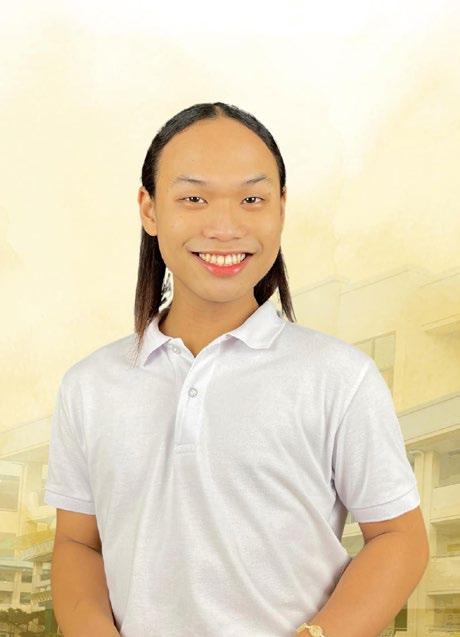
“
Ending
Greg Ryan So Associate Editor
the utang-na-loob culture is not about being
unmindful
or
ungrateful
of our parents’ sacrifices but being bodacious and free. It means that we acknowledge and owe our parents for raising, nurturing and caring for us.
WhenI grow up, I promise to give my parents a picturesque life, sitting on our house’s balcony Sipping coffee or tea while enjoying a magnificent mountains view in our rest house in Baguio City-Perhaps, they could also go to vacation whenever they want in some pristine beaches in like Siquijor or Siargao or just enjoy their vacation without interruption when sleeping when 4:30 A.M alarm to go to work. A hit wasn't something my parents have ingrained in me. As someone who excels academically since elementary, it was my simple way of showing my parents how much I appreciate them.
but the slow pace of investigations and the possibility of further violence leave an unsettling question: how many more lives must be taken before comprehensive preventive measures are put in place?
A Teacher's Molestation of a 12-YearOld Student
In Sta. Barbara, the sanctity of education was shattered when a public-school teacher was accused of molesting a 12-year-old Grade 6 student. The incident, which reportedly took place under the pretense of a graduation practice, has stirred outrage among parents and the community.
The teacher, who had allegedly molested the child multiple times, was only arrested after the young victim bravely came forward to tell his parents. This case exposes an even more harrowing reality—those entrusted to nurture and protect our children in schools can also be their worst predators. Parents are now left questioning the trust they place in educational institutions, and the Department of Education is under pressure to ensure that such abuses are not only punished but prevented in the future.
Justice, Comprehensive Education, and Better Protection
The recent surge in sexual violence cases in the province is a call for immediate and decisive action. Law enforcement must expedite investigations and legal proceedings to swiftly bring perpetrators to justice. Schools and communities should provide comprehensive education on consent, respect, and the dangers of predatory behavior, extending this education to both children and adults. Victims need access to psychological counseling, legal support, and safe spaces for healing. Communities must come together to create safer environments through local initiatives like neighborhood watch programs.
As we grapple with these horrific events, we must never forget that behind each headline is a life taken or forever altered. Pangasinan must rise to the challenge, ensuring that every citizen—especially its most vulnerable— can live without fear of violence. Let these tragedies be a turning point, not just for justice but for lasting change.
That’s the culture of ‘utang na loob! Oftentimes, this core norm of Filipino culture has taken on a new light in previous years, with past generations then the ‘Utang na loob’ gradually becoming a chain of gaslighting that winds as young individuals reach their full potential. Believe it or not, even public figures are not accepted to public scrutiny in terms of “giving back” to their parents when reaching new heights in life like Carlos Yulo, a two-time Olympic gymnast, and his mother, which became viral in social media, leading to a long-standing debate among filipinos.
In Filipino culture, “utang na loob” has formed a bond between parents and children. When this norm is taken excessively, this so-called obligation could potentially trap or drain individuals in a cycle where they feel obliged to give back their parents’ sacrifices by solely sacrificing their own dreams and sake. And at some point, it is she of the cycle in our culture that needs to be cut from how we live without the intent of disrespecting our tradition but to build healthier family relationships.
Many young individuals, if not all of them, typically ask the question: “ Why do our parents expect us to provide for them once we become successful or even ‘Iahon sa Kahirapan’ like it has some sort of debt we have to pay diligently. This exact concept of Filipino parents views their children as investments in the future. In reality, our parents have sacrificed much of their life for us physically,emotionally and financially from birth to now and somehow expecting us to ‘pay it back’ by simply giving everything they have given us back.
From there, the essence of ‘utang na loob’ becomes an idea that in the future while we help ourselves become successful in our chosen careers, we also become our parents’ caretakers, payments or investments. And unfortunately. At the expense of our own dreams or passions. The gravity of this expectation is rendered on the shoulders of young dreamers that holds back young Filipinos’ capacity to pursue their dreams and respective career paths, chaining them in a cycle of obligation that winders their personal growth and freedom.
It is evident in Yulo’s case. The recent Fuel between him and his mother mirrors the same significant issue many Filipino Families Face: children are gaslighted with an idea that they owe their entire lives to their parents. An idea that at the end of the day, children must work tirelessly and sacrifice their ambitions and dreams in expense of their parents ‘ wellness and expectations making them feel obligated more than concerned.
Do not misinterpret it. As someone who is very close to my parents and vocal about what I’m willing to give them in the future, I believe that caring for our parents should be discretionary,not merely obligatory. The concept should not form a sense of love and respect and not guilt or pressure. Parenting should empower the younger generation to become family-oriented and not gaslighted in an idea that they must repay what their parents have done for them. Ending the utang-na-loob culture is not about being unmindful or ungrateful of our parents' sacrifices but being bodacious and free. It means that we acknowledge and owe our parents for raising, nurturing and caring for us. Perhaps, row is the night time for us to stop expecting young people to set aside their passion and sacrifice their future for their parents. Gather, let us foster an environment of love where children are free enough to become happy with their lives, while securing their parents’ state and lives out of good light, not gaslight
Let us instill in the minds of next generations that they are free to navigate in their own journey and parents are grateful in seeing them become successful in life.


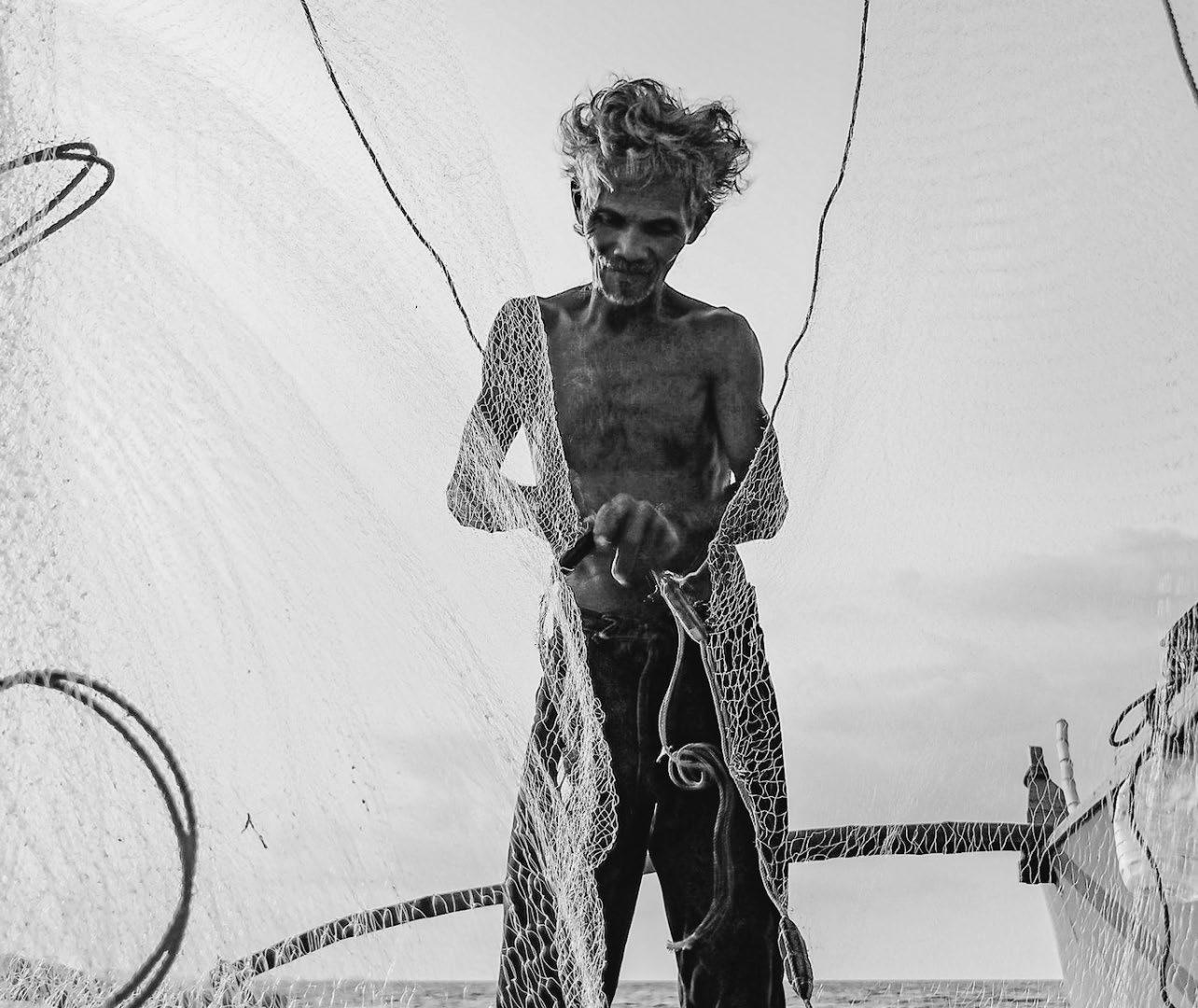

T
he 2024 Survey on child labor in the Philippines revealed that out of 29 million Filipino children aged 5 to 17, around 5.5 million were working, with nearly 3 million engaged in hazardous labor. The survey was conducted by UNICEF, a global organization saving, protecting, and empowering children and adolescents, with support from the International Labor Organization.
The result highlights the grim reality faced by many Filipino children, who are exposed to dangerous working conditions. Many of these children, including those in communities like Mayombo, Dagupan City, are employed in hazardous jobs. They are exposed to harmful chemicals, use sharp tools, and endure other unsafe conditions. Long working hours, limited breaks, and the threat of abuse—both physical and psychological—define their daily lives. Such child labor is particularly prevalent in Central Luzon, Bicol, Northern Mindanao, and Western Visayas, but exists in other regions as well, including Dagupan City. Anton, a 16-year-old from Dagupan City, is one of these child laborers.
“I started selling vegetables at the market when I was eight,” Anton said. “My family needed help, and I knew I had to do my part.” By age eleven, he was working in a bake shop, and by fourteen, he became a fisherman. He eventually became a port laborer, hauling
drums of fish from truck to the port from 7 PM to 4 AM, earning only P30 per drum—about P290 per day.
“My parents wanted me to work, but it was my choice,” Anton added, emphasizing his determination to support his family despite the harsh conditions.
The City Social Welfare and Development Office (CSWDO) in Dagupan City advocates for addressing the root causes of child labor rather than blaming parents. According to the CSWDO, systemic issues like poverty, lack of education, inadequate healthcare, and limited job opportunities drive children into labor.
These factors also contribute to increased school dropout rates, with children like Anton choosing work over education.
“When you need food on the table, holding books and pens doesn’t seem like an option,” Anton admitted.
To combat child labor, the government has passed several laws aimed at protecting children. Republic Act 7610, also known as the Child Protection Law, addresses various issues concerning children, including child labor. Republic Act 7658 prohibits the employment of children under 15 in both public and private sectors, while Republic Act 9231 strengthens protections for working children by regulating their working hours and ensuring their access to education, medical, and legal support.
Rochelle Porras, Executive Director of the Ecumenical Institute for Labor Education and Research (EILER), emphasized, “Poverty is the root cause of child labor and should be the primary focus of government intervention.” Without addressing poverty and the lack of decent jobs for adults, children will continue to be forced into labor.
One promising solution is the reintegration of child laborers into the education system. EILER, in partnership with the European Union, has launched a pilot project called “Bata Balik Eskwela,” aiming to bring child laborers like Anton back to school.
EILER also offers livelihood programs to help affected families make up for lost income when children leave work to study. “We hope to give these children a better chance at a brighter future,” Porras said, highlighting the importance of providing families with alternative sources of income.
These initiatives offer a silver lining for Anton and many others like him—an opportunity to return to school and build a better future without the heavy burden of financial responsibility.
“I want to go back to school,” Anton expressed, “I just need a chance.” By addressing the root causes of child labor and supporting their families, such programs ensure that children can focus on their education, which is essential for building a brighter future for all.


As the school bell rings, signaling the start of recess, the calls of student-vendors fill the air.
“Maliw la! Mura lang!” The usual chatter and laughter of classmates transform into a lively marketplace, where eager students exchange their coins for snacks, candies, and homemade delicacies. In the bustling environment of East Central Integrated School (ECIS), these business-minded learners fuel the life of “Paglalako” culture.
Among them is Raquel C. Estero, a Grade 12 HUMSS student who sells refreshing homemade shanghai or graham. With each affordable piece, her classmates stomach up from the academic exhaustion. “Ako ay naudyok na magbenta dahil gusto kong makapag tapos upang makapasok sa kolehiyo at masuklian ang lahat ng sakripisyo na ibinigay sa akin ng aking pamilya,” Raquel says. She balances her studies and her business by selling her homemade delicacies only on break times.
However, Raquel isn’t the only one leading on the hustle of recess. Meet Jam Martinez, a Grade 10 Amorsolo who has turned her recess into a small business agenda. “Bili na, bili na!” she calls out, showcasing her selection of snack like various flavored ice cream cone snacks as classmates flock to her during their break. For Jam, this is more than just a way to earn extra pocket money; it’s a lifeline that helps cover school supplies and other expenses. “Ito ay nakakatulong sa akin dahil dito ko kinukuha minsan ang aking baon o mga kailangan bilhin,” she shares.

Beneath the morning sun, as the smell of saltwater drifts through the air and the rhythmic slosh of the waves echoes in the background, people from the community gather by the shore. Fishermen, children, neighbors, and even elders who no longer go to sea all unite to help fill a single large drum with freshly caught fish. There are smiles on their faces, a gentle joy that can be seen as their hands work in synchrony, each carrying their small contribution, big or small, to fill the banyera.
In this small fishing community in Dagupan City, it is a heartwarming tradition that continues to inspire anyone who witnesses it – to fill the drum with fish. More than just a common saying, it is a living symbol of the collective strength, resilience, and spirit of Bayanihan—the community-driven, volunteerism deeply embedded in Filipino culture.
“We do it together because this is how we make sure that nobody gets left behind,” says Ate Kori, a mother of three and a fisherman's wife. She places her own share of fish into the drum and glances over at her neighbors, all doing the same. “If someone had a bad day out at sea, we help them. Today it’s them; tomorrow it could be us.”
Another member of the community, Kuya Tonying, a fisherman, shares his thoughts while resting on the shore after a long morning at sea. “Filling that drum isn’t just about the fish,” Tony explains with a chuckle. “It’s about making sure everyone—whether you had a good catch or not—has something to bring home.” He gestures to the overflowing drum that sits in the center of the gathered crowd. For him, and many others, filling a drum of fish goes beyond survival; it’s a testament to their interconnected lives, and their ability to share their success with each other.
Watching them from afar, you can see the genuine delight in their interactions. Children weave through the crowd, playing with the stray cats that are eagerly waiting for a scrap. Elders sit in small groups, gossiping and joking around, knowing that they can still help in counting and sorting the catch. The scene is alive with life and hope, a clear reminder that no one in the community goes hungry, and no one has to suffer alone.
As the sun continues to rise, each of the households takes their share—a portion from that single drum, which holds not just fish but also the care of each member for another. They have each contributed to filling it, and now they all share in the reward. It’s a small yet powerful gesture that holds the community together, day after day.
Ate Kori puts it best, her eyes softening as she looks towards her children. “When my kids see this, they learn that what matters most isn’t how much you get, but how much you give to others.” For her, this tradition is something far more valuable than just fish—it’s a way of living, one where every person, no matter how small, plays a vital role in the whole.
“Here in Dagupan,” Kuya Tonying adds as he packs his nets, “we may not be rich in money, but we are rich in each other.” And indeed, that wealth—of compassion, unity, and the shared determination to help one another—is what makes “Isang Banyerang Isda ( A Drum Filled with Fish)” a truly remarkable practice.
On the shores of Dagupan, you will find a story written not with words but with the actions of everyday people—a community who understands that filling a single drum with fish is not just about feeding stomachs but about nourishing souls. It’s about making sure that when one person prospers, everyone prospers. And when you hear their laughter, see their smiles, and feel their shared happiness, it’s clear: in Dagupan, the true catch is the enduring spirit of Bayanihan.
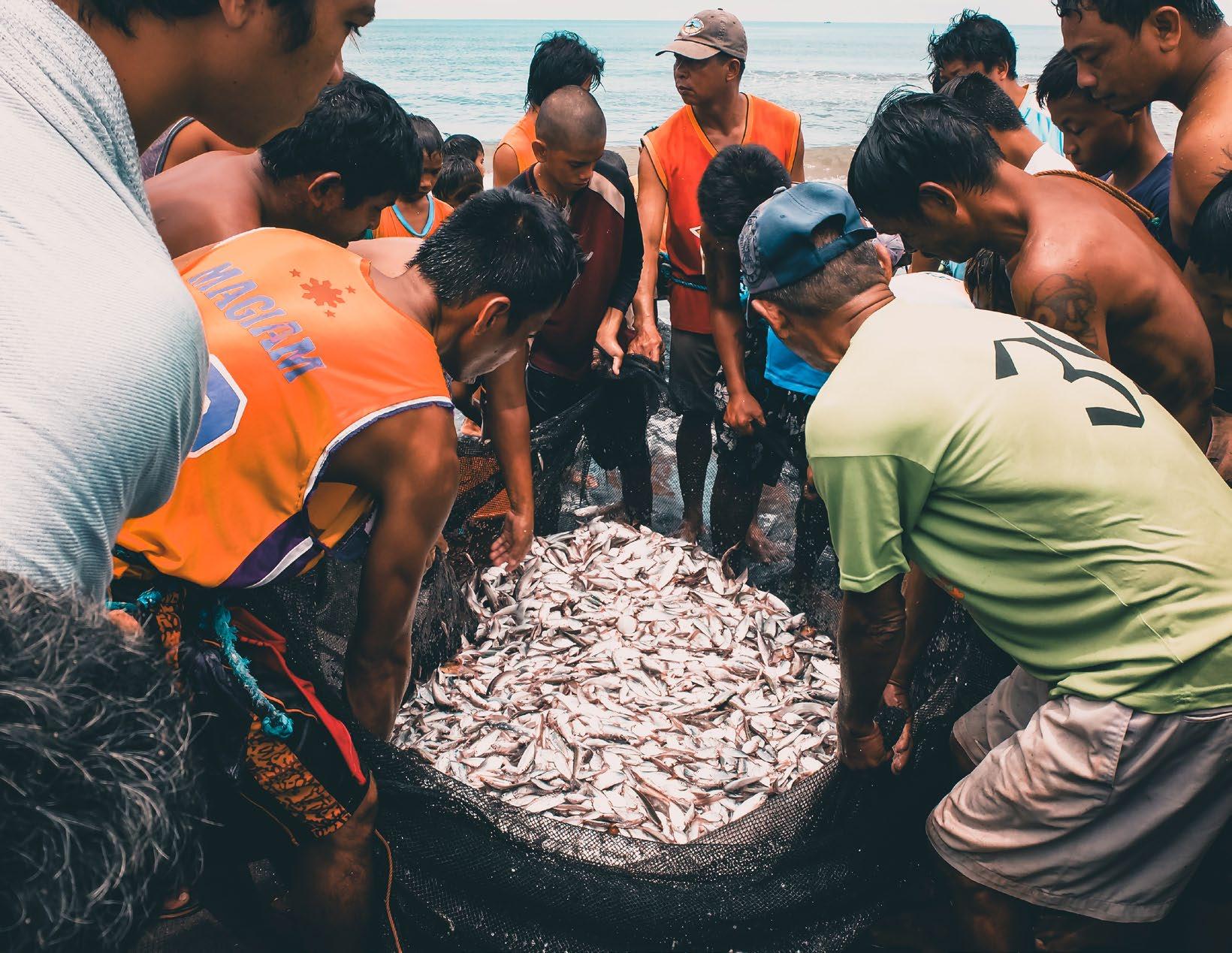


Then there’s Muhammad Raffy R. Mato, a Grade 11 HUMSS student known for his popular baked goods like donuts. His donuts have become a hit among students, creating a buzz every recess. “Gusto kong makapagtapos ng kolehiyo,” Mark explains, sharing how his entrepreneurship is driven by the passion to help his family and himself to finish college.
Not to be outdone are the twin brothers, Joshua G. Lopez and Joseph G. Lopez, who are making waves with their irresistible biscuits and chip curls. These Grade 12 ABM students have turned snack time into a dynamic duo venture, calling out, “Ga! Mangaliw ka la!” For Joshua and Joseph, this is more than just selling snacks; it’s about working together to save for their future. “Kaya namin ito dahil dalawa kami,” Joshua quips, as they expertly juggle their studies and their budding business with a teamwork that only twins can master. While they face challenges such as balancing academics and “paglalako”, the rewards of their efforts are vital. “Puyat, pagod, at minsan ay distraksyon sa klase pero nakakaya naman,” Raquel admits, yet she finds motivation in her desire to succeed. For Jam and Muhammad, this is a hard work that becomes worth it in the end.
As the recess bell rings again and the students return to their classrooms, the impact of these learners lingers in the air. They are the epitomes of hard work and determination, reminding us all that even the smallest efforts can lead to meaningful change. In the halls of ECIS, the “paglalako” culture is alive through the power of these young hustlers.

Written By: Najerah Mato Photo By: Joshua Bileg
Every new generation of students brings different challenges, and our approach to teaching has to adapt.
In the four corners of the room at ECIS, Dagupan City, understanding students born in 2005 requires a deeper reflection on the practices from the teacher’s perspective. These students are not just another cohort—they are the first generation raised entirely in a world of smartphones and rapid social media. If we fail to recognize these students' unique struggles and strengths, we miss the chance to meet their needs truly.
"It feels like there's always so much pressure," says Kristine, a Grade 11 student. "There’s pressure from our families to do well, pressure from social media to look perfect, and pressure from school to keep up. It’s exhausting!"
Kristine's sentiment captures what many of her peers feel. Unlike previous generations, students born in 2005 have grown up with technology in their hands, and with that, they’ve inherited both incredible opportunities and unprecedented stress. While technology allows them to access information quickly, it also means they never truly disconnect. The expectation to always be available—always “online”—creates a unique challenge that teachers and parents may struggle to fully understand.
"I think the biggest struggle is balance," adds Carlos, another student. "Everyone wants us to focus on academics, but we must also learn about life. Most of us have a lot of worries, and it's not easy to balance everything when we're also being compared to others online."
Many students are burdened by an overwhelming expectation to excel academically while navigating a digital landscape filled with comparison.
This presents a critical question for ECIS teach-
ers: How do we help these students thrive in an environment that constantly demands perfection? How do we provide them with the skills they need for real life beyond the classroom walls?
These students have also grown up witnessing economic instability, a global pandemic, and issues like climate change being at the forefront of conversation. They carry the weight of global crises that previous generations had the luxury to experience from a distance. As a result, their outlook on the world is often cautious and, at times, anxious.
“Sometimes I feel like adults don’t get us,” Kristine shares. “They think it’s easy because we have technology, but the technology just brings different problems. Sometimes, it’s hard to keep up with everything happening around us.”
Teachers have a crucial role to play in responding to these challenges. It’s no longer enough to teach theory or academic subjects—students need skills that help them cope with stress and navigate a constantly changing world. They need us to listen, empathize, and adjust our practices to make learning a supportive experience rather than an added pressure.
“I wish we had more time to just focus on things we care about,” says Carlos. “Sometimes it feels like all we do is prepare for exams. But there’s more to life than exams.”
To guide these students effectively, we must rethink our teaching methods. This could mean extending deadlines, allowing assessment flexibility, and giving students time to focus on their passions. Understanding students born in 2005 means recognizing that their struggles are real, complex, and require empathy. The mission for ECIS teachers is clear: adapt, support, and be willing to change so that students are prepared for exams and the life that awaits them beyond school walls.
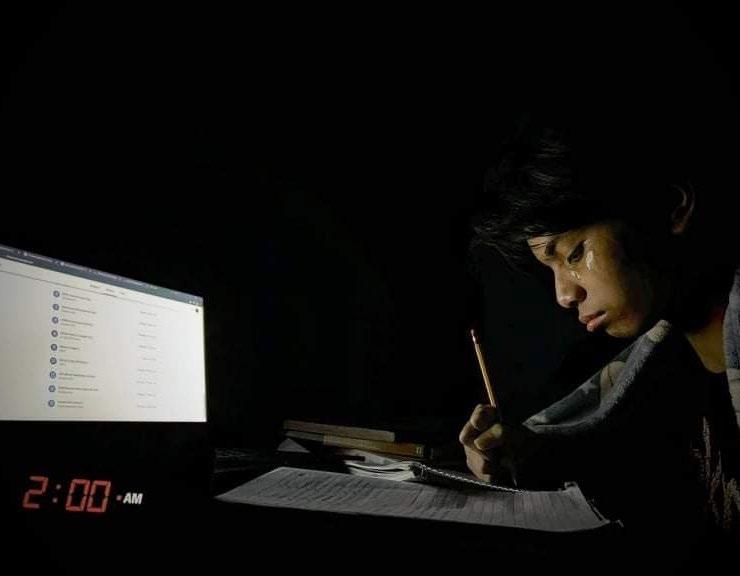
From
D
uty to God, duty to others, and duty to self — are the most important values that resonate with a true scout. Laurence Kier M. Viray, a regional successor of Boy Scouts guided by these values, outstands everyone as he was chosen as one of the top 10 outstanding Boy Scouts in the Philippines. He continuously dedicates his life to showing love for the country and fellowmen.
Viray said, “My father, a Scouter and a Wood Badge holder, inspired me to join Boy Scouts of the Philippines. His dedication and passion for scouting strongly influenced my decision to become a part of the movement.”
He was first introduced to scouting when he was in elementary and joined a camping camp in Natividad. He felt a sense of excitement and fulfillment, and he wanted more. For this reason, when he was invited to join a backyard camping when he was in junior high school by his Outfit Advisor, Mr. Anacencio L. Aguilar, he didn’t miss the opportunity,

Written By: Najerah Mato
Photo By: Joshua Bileg
for he knew it would surely teach him life-long lessons that would prepare him in the real world by instilling discipline and teaching him to stay alert in various situations. He said, “The challenges you face in scouting help you to develop the ability to make quick, informed decisions and take responsibility for your team.”
As the senior scout at East Central Integrated School, he has been responsible for leading and inspiring others to become active and passionate leaders to foster lasting community initiatives that serve as a model for future Scouts. He goes above and beyond to make a great impact on the lives of his fellow scouts and in the community as well.
His commitment and dedication to continuously help in community service activity led him to pursue his part in establishing TABANG HUB. This community project allowed him to bring aid, nourishment, and support to those in need. This experience was rewarding because he had seen its positive impact on the community. He aims to continuously develop his leadership skills and leave a positive mark in his community through scouting projects like TABANG HUB.
The Life Saving merit badge holds significant meaning for him, for he earned it after the incident where he saved the life of an injured student by applying first aid and rushing him to the nearest hospital. He said, “That moment solidified the importance of the skills I learned in scouting.”
His greatest achievement was becoming a BSP National Finalist, where we underwent a final interview and demonstrated his skills in Cebu City last October 14-19, 2024. With the support of his family and the help of his Outfit Advisor, Mr. Anacencio Aguilar, he was recognized as one of the Ten Oustanding Boy Scouts. His journey into becoming an outstanding boy scout makes him embrace every experience, big or small. He applies the lessons of scouting by embodying the principle of being a "kindness boomerang," meaning he spreads kindness wherever he goes. He lives by the motto, "Once a scout, always a scout," and he ensures he incorporates the values of preparedness, integrity, and helpfulness into his daily actions as a service leader to all.

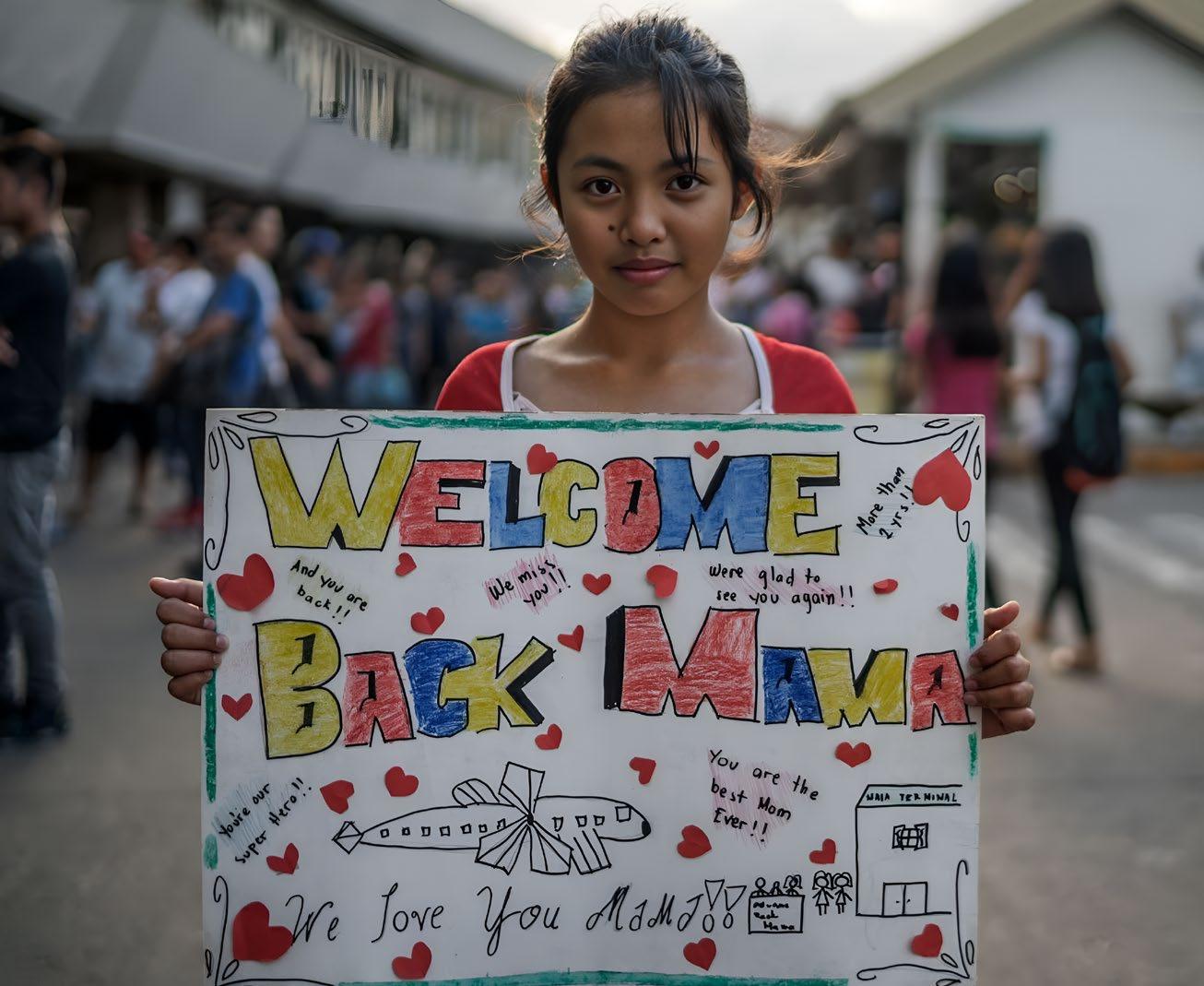


IBy: Najerah Mato
n Herrero-Perez, Dagupan City, 13-year-old Daniela Junatas lives with a bittersweet reality. Her mother, Ivy, is among the millions of Filipinos working overseas who send money to sustain not only their families but the entire economy of the Philippines. Yet, for Daniela, the remittances her mother sends are not just money— they symbolize her absence and the sacrifice.
"I know my mom loves me," Daniela says, her small voice carrying a hint of pride mixed with sadness. "She sends us money for school and buys us things. But sometimes, I want her here with me." Daniela’s mother left for Hong Kong when she was only five. While her absence has ensured that Daniela’s school fees are covered and there is always food on the table, it has left a void that even the best toys cannot fill.
Daniela’s days are much like those of other East Central Integrated School students. She’s a diligent student, her teachers say, and she often speaks of her dream of becoming a nurse someday. "If I study well, maybe in the future I can take care of my mom and she won’t have to work so far away," she says, with a hopeful smile. But it’s not lost on her teachers that Daniela’s resilience is born out of necessity, not choice.
The Philippines has over 10 million overseas Filipino workers (OFWs) who endure separation from their families to provide a better future. This sacrifice, seen in millions of households, is often told through numbers, charts, and economic impacts. But Daniela’s story—one among many—shows the true
cost of this separation. Her grandmother, Lourdes, who now serves as her guardian, notices the toll it takes. "She’s a good girl, but she misses her mother terribly. Sometimes, she cries at night, but thanks to video calls, Daniela and Ivy are still connected," she shares, her voice soft with the weight of witnessing her granddaughter's quiet heartache. For Daniela, school has become her escape and motivation. Every day, she tells herself that studies are her path to a future where she can reunite with her family and her mother can come home and stay. Her mother calls when she can, sometimes catching her in between Daniela’s homework or while playing with her friends. These calls are brief but cherished. “She always tells me to be a good girl and to study hard," Daniela says. "I know she’s working hard for us, but sometimes, I wish she was here to say those things in person."
The absence of a parent affects every part of a child's life, from the emotional support they miss to the simple act of having someone to help with homework or attend a school play. "You can see it in her drawings," Daniela’s teacher observes. "She often draws her family with a big heart around them. Even in her art, she’s reaching out for the family she wants to be whole again."
For many like Daniela, resilience has become a part of their young lives, molded by the sacrifices of their parents. Yet, as she sits alone after school waiting for his grandmother, Daniela’s story reminds us of the profound emotional toll often hidden beneath the remittance numbers. The sacrifices of millions of Filipino workers abroad are not just stories of success—they are stories of love and longing that extend far beyond borders.
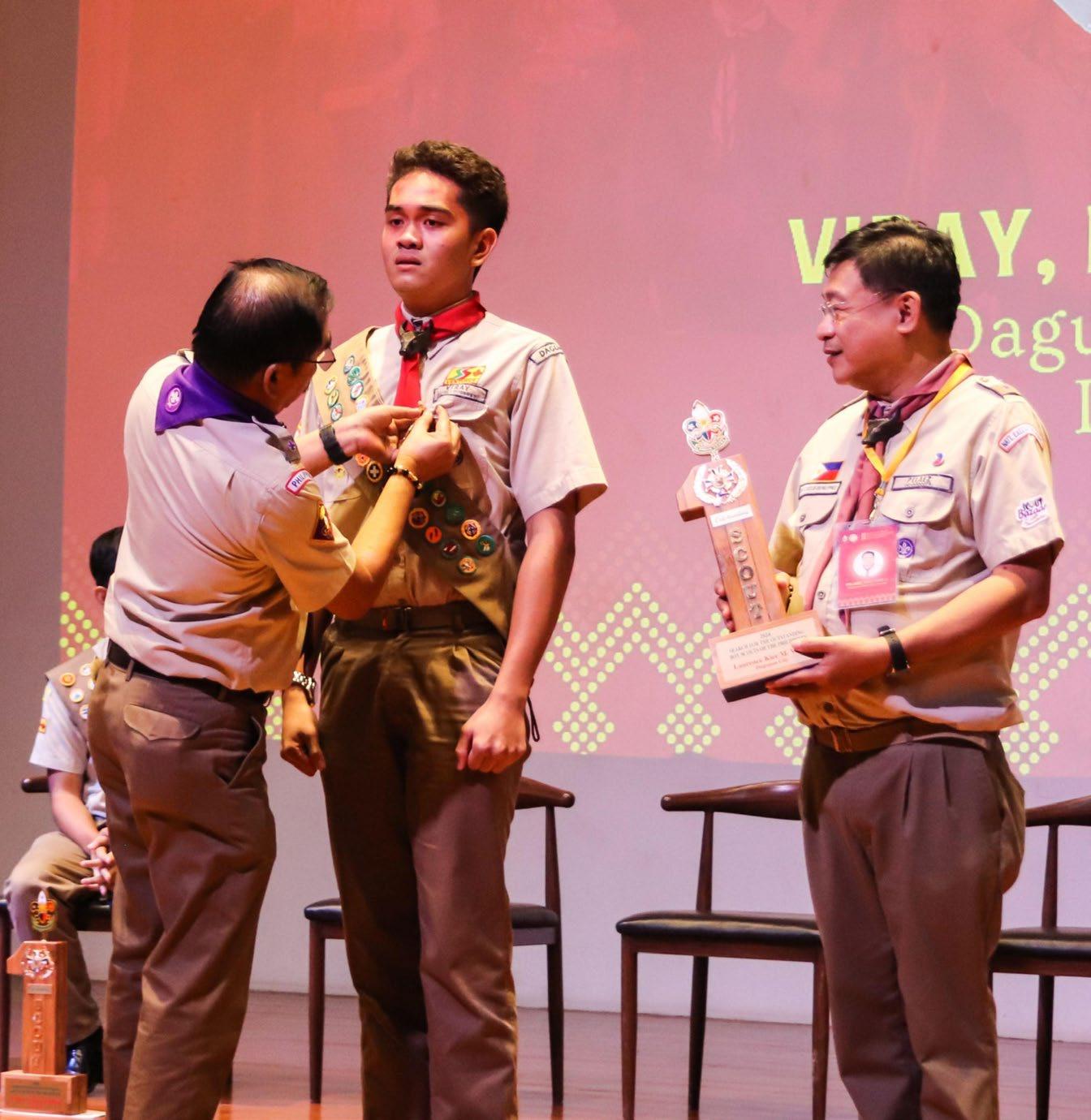

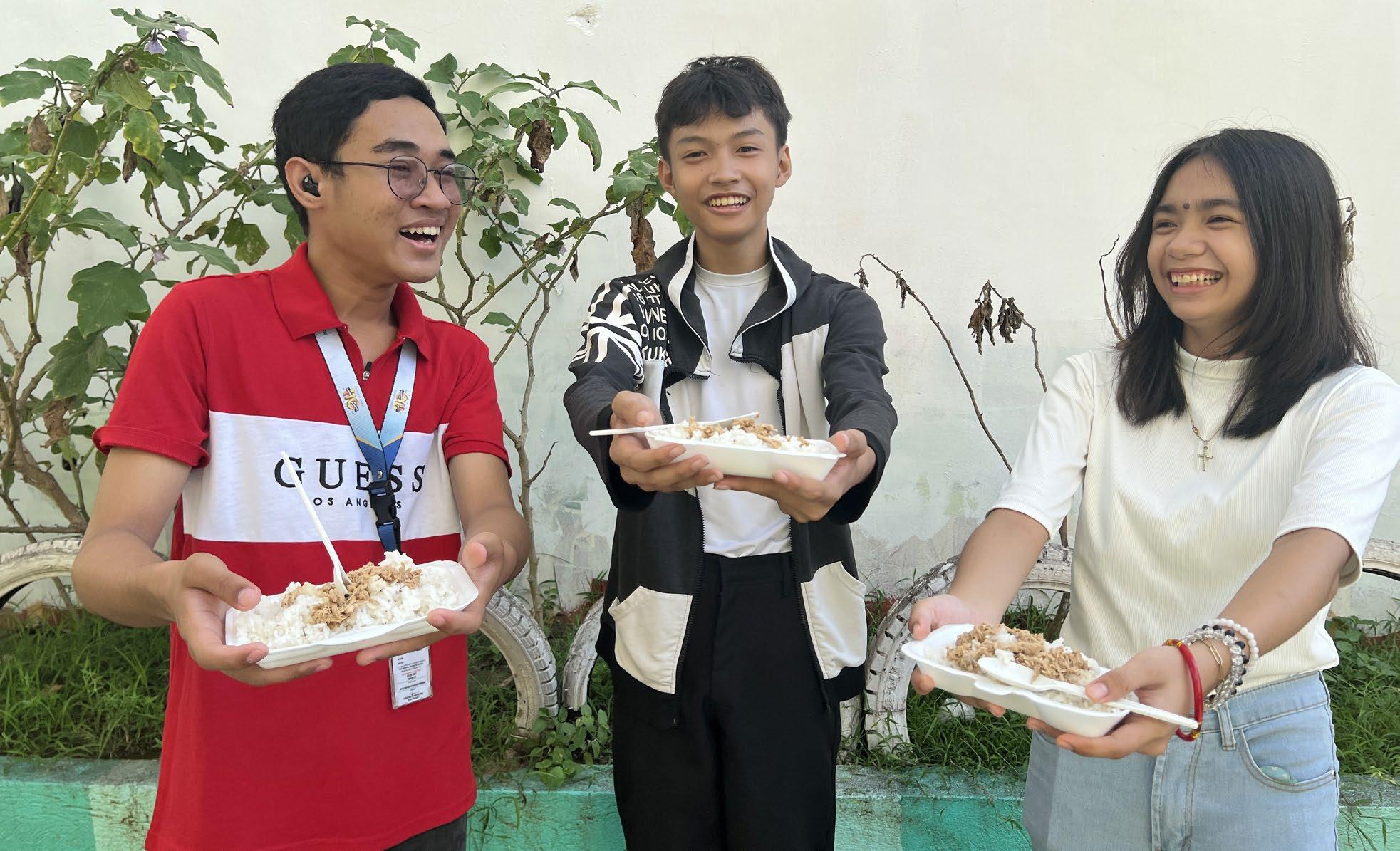

Written By: Najerah Mato
Photo By: Joshua Bileg
This cost-effective promise can be found in the humble pastil or pater—steaming hot rice topped with sautéed shredded meat, wrapped in a wilted banana leaf, sometimes paired with a side dish of choice. Commonly sold in stalls along the streets, it’s perfect for those searching for a budget-friendly, on-the-go meal.
Originally hailing from Maguindanao, pastil has since spread across other locations in Mindanao—with General Santos City (GenSan) being a popular location to try the binalot-style meal. Its popularity can be traced back to a scene in Mindanao State University—General Santos City, where students struggled to find cheap food. Due to extended neglect
from the government during the 90s, people sold the delicacy at a low price.
At East Central Integrated School (ECIS), pastil has become a go-to choice for students during breaks. With the school day filled with classes and activities, students seek affordable and satisfying meals, and pastil fits the bill perfectly. It’s a snack that not only fills their stomachs but also brings a sense of comfort.
Ildefonso Cayago Jr., a Grade 12 HUMSS student, appreciates the practicality of pastil. “Kasi ang pastil ay swak na swak sa budget ng mga ECIS student,” he shares. The price of pastil is within reach for most students, allowing them to enjoy a hearty meal without spending too much of their “baon.”
Another pastil lover, Wency Oviedo, highlights the appeal of this delicacy.
“Hindi mahal ang pastil sakto lang sa
baon ko sa araw-araw, kumpara sa ibang pagkain na mahal nga, ay hindi pa nakakabusog,” she explains. The combination of affordability and satisfying portions makes it a popular choice among ECISians who are always on the go.
The popularity of pastil at ECIS extends beyond its taste and price; it fosters a sense of community. Mirasol Pagaduan notes, “Kaya sikat ang pastil sa ECIS kasi solid na solid ito; masarap na nga, mura pa.” Pastil becomes a paved culture in the school, providing a sense of belongingness among ECISians.
Vendors at the canteen and student entrepreneurs selling pastil around the school grounds contribute to its popularity. And as the pastil craze continues to grow, it’s clear that this simple dish has carved out its special place in the hearts of ECISians.


DBy: Gemmarie Binghit
o you feel like an outsider, wandering through unfamiliar territory at East Central Integrated School? Fear not! This is your one and only guide in becoming an insider in this school. With this guide, you can ensure that you're always in the loop of campus culture.
A is for "Ate Coco." Way to call a friend.
B is for "Bawi ko next quarter." A phrase students use when they didn’t achieve the desired outcome, but they’re determined to do better next time.
C is for "Cramming." That last-minute rush before exams, a universal experience for every student.
D is for "Drop na." The phrase used when they got low score in quiz.
E is for "Eyyyyy." Bini expression to hype someone or something.
F is for "Frennnn." To call your classmate or friend.
G is for "Gwaenchana." A Korean phrase that translates to “it’s okay.”
H is for "Hell Week." That dreaded week where every deadline collides, and campus life becomes an endless cycle of projects, exams, and sleep deprivation.
I is for "Ihhh?" A sound you make when you're unsure of what to do or what’s going on.
J is for "Jejemon." A term used for someone who types in an exaggerated, "corny" way, using unnecessary characters and emoticons.
K is for "Kurakot." A term used to describe someone who is
L is for "Laban." Despite the countless struggles, students are filled with resilience and determination, always ready to fight for their dreams.
M is for "Manifesting." The act of hoping and believing that what you desire will come true.
N is for "Nyyeeeh.” Expression used when someone is saying a bluff
O is for "Of course not." The sarcastic response when asked if you’ve finished your work.
P is for "Periodt, queen." A phrase of agreement and empowerment, often used in conversations to rally support and uplift each other.
Q is for "Quiz-sung." That feeling of relief after acing a quiz. You've mastered it— good job!
Q is for "Quiz." That inevitable test that comes up when you least expect it, but with preparation, you'll ace it.
R is for "Recitation." The moment when someone confidently participates in class, sharing their best insights.
S is for "Soar High." The motto that encourages every student to aim for their best, especially at a school like Science High School.
T is for "Torque." A word from physics class, but it’s also a reminder to apply pressure when needed—whether it's in your studies or life.
U is for "Umay." That feeling of being overwhelmed or fed up, often from too much work or stress.
V is for "Vow." The solemn promise to stay committed, whether it's to academics, friendships, or personal goals.
W is for "What a crucial week!" A common phrase during the busiest weeks of the term, where everything seems to be happening at once.
X is for "Xori." A playful way of saying "sorry" among friends, often used when mistakes are small and easily forgiven.
Y is for "YOLO." You Only Live Once—an expression used when taking bold actions or risks, reminding you to live fully.
Z is for "Zzzz." That much-needed sleep after a long, exhausting day of school and activities.
With these letters, you'll not only master the language of Science High School but also navigate through its culture with ease. You're now equipped to take on every challenge with a little humor and a lot of heart!

Written By: Dominic Anasco Art By: Rhainny Dimaapi
It’s finally here – the inevitable Mondays, another exhausting day at school. My efforts in waking up early have always been a struggle. But every 6 am, the rooster crows, small to big multitudes of quakes that signal the train's passing in the railways reach our house. As the train draws nearer, a message seemingly accompanying it greets me, “Good morning! Wake up.”
Once all the construction and planning were done, the railways were situated under the cities found along the lengthy route that connects Dagupan and Manila. I'm always thankful for the relief of being able to ride this train as I finish the errands given by my parents. Under the sun's scorching heat that hits the metal roofs of the train, people are given access to better and faster transportation.
Overhearing from the elderly people I ride with, who talks about the origins of this train and the minds that motivated the construction of this train, information goes around like this: “On November 24, 1892, Philippine National Railways started its operations on its
railway from Manila to Dagupan. The project was called ‘Ferrocarril de Manila-Dagupan’ during the time of the Spaniards when the Philippines were under colonization.” Hearing about this, I have always been amazed at the minds that initiate such construction.
As the train continues to travel amidst the bustling cities surrounding the railway, the transportation service given to the people proceeds. The railway was so important to the country as people could travel from different places by train. It was passed from the Spanish period to the American Period during the 1900s called the Manila Road Company, then later handled to the Philippines as it operates by itself, finally named the Philippine National Railways or the PNR as we all know.
Decades have passed, and the only memories left from the trains are remnants of the railroad that have long been consumed by rust. I have been used to it, used to the everyday scenario where I wake up and remember a fragment of my childhood. Staring at it, I now see the remains of the railway that used to be part of the activities I have done for consecutive years – a never-ending process of looking for a living.
But now, the rumbling and chugging of the train has gone. You can only hear the chatters of children as they play in the railways. I also used to be there before, a squatter residing beside the railways.
As more and more passengers were brought home to their families and wherever their destination was, an unprecedented series of events began to unroll. The traumatic experiences we have encountered were mainly the reasons – the arrival of natural calamities that astonished us. Under the gray haze of the sky were smoke and ashes that came from the catastrophic eruption of the Mayon Volcano, one of the strongest eruptions that has occurred here in our country. Disastrous floods that come crashing along the concrete city grounds to the depths of the rivers also added to the destruction of the railways. Such events gave birth to squatter areas where people began residing and building houses beside the devastated railways that are now worn down and unavailable for the masses. Transportation, one of the most essential things integrated into our daily activities, is now unavailable for access to people.

What good is it to find a cure to a person’s illness if the government budget is not funded on research and development in the first place?

Written By: Rhainny Dimaapi
Art By: Joyce Nievo
On a breezy dawn, Jenny, a 25-yearold medical research intern, braves the surpassing heights of Mt. Hulao, whose topography represents a steep road in which one wrong step can lead to an unfortunate demise. Sweat and exhaustion are visible in her visage as she has been hiking for more than an hour to gather information about the outbreak of an endemic, infectious disease in Sitio Kalbaryo. She then contemplates, “What is the essence of doing this — unprotected, overworked, but not well-funded — risking my life for the betterment of a community?” The government’s treatment of medical researchers has been like this since immemorial, considering their jobs somewhat useless and unprofitable. After a two-hour-long journey, she finally reaches the place and commences her work…
Philippine Context
It has been known from various news outlets that there is a lack of support from the government in terms of funding the scientists. This is because, even in these trying times when medical attention should be of paramount concern, the medical budget was not prioritized; rather, other matters were given attention, such as shutting down a TV network, beautifying a historical scenery, and, worst, spending all budget in military funds. These are insults to Filipino medical scientists who have endured the current situation despite inadequate support and funding from the Philippine government. Science Transformation Limelight for Virtual Communication. The Zoom platform is mostly used nowadays to have more diverse and larger people participating in scientific virtual conferences. Virtual communication reduces transaction costs and the carbon footprint gained from traveling. It also allows research collaboration to be conducted flexibly. Pressure in Country’s Funds. Countries’ funds are stifling because of the increasing debt worldwide. This results in reduced funding for

all agencies and institutions, which research institutions are the ones who are affected the most since they are in need of more funds to at least mitigate the effects of pandemic. However, in developing countries, the brain drain rate has increased because of the budget cut.
Making the Philippines R&D-Friendly
The Government Procurement Reform Act (RA 9184) is designed to have a transparent and accountable procurement process to avoid corruption. However, based on scientists’ experiences, tiresome paperwork for liquidation is still present, and these procurement laws still cannot protect scientists from monetary-abusive suppliers. With this, a reformation in the procurement process is needed.
The current education system, unfortunately, is characterized as colonial, commercialized, and fascist. Colonial because teachings are very Western-oriented and are not contextualized.
Commercialized because tertiary education is still inaccessible for some, resulting in work exploitation (cheap labor), which further leads to brain drain. And fascist because education is meant to pacify people; it is repressive because it teaches the children that life abroad is better than life here. Education should be mass-oriented, national, and science-education-focused to solve these. Education should be designed so that Filipinos will start to love their own culture, not the colonial ones. The science, research, and development culture should also be integrated early into the education system to encourage young students to pursue research careers.
After an arduous day of gathering and analyzing information in a far-flung place, Jenny peacefully sleeps in her tent, showing her fatigue but still maintaining a smile on her lips. She loves her work despite the inconsiderate working conditions she has been experiencing.
Jenny is a representation of Filipino researchers who continue to remain hopeful that, soon enough, their voices will be heard, things will get better, and the scientific sector will thrive. At the heart of her wishes and ideas is a dream to unite the Filipino scientific community to provide the ample knowledge the country needs to go further.

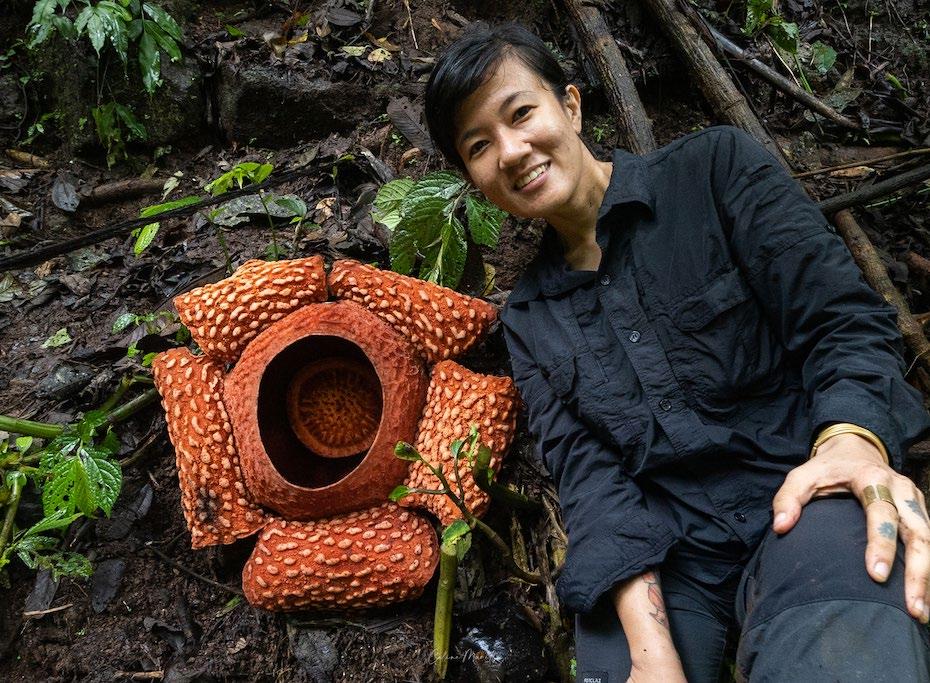

In the fast-paced digital landscape, where fleeting trends and viral dances dominate, it may seem surprising that TikTok has become a powerful platform for environmental advocacy. Yet, once dismissed as a Gen Z playground, this social media app is now a dynamic space where pressing issues like biodiversity and sustainability are being brought to the forefront. With its massive user base and bite-sized, engaging content, TikTok has opened up new avenues for conservationists to tell their stories—and inspire real-world change.
Leading this movement are couple creators like Celine and Dennis Murillo. Before TikTok was a household name, Celine, an established travel writer, had been championing conservation, particularly at the Masungi Georeserve in the Philippines. Now, with her husband Dennis, a videographer, she’s leveraging the platform’s unique storytelling potential to connect with a global audience. With 150,000 followers and over 1.4 million likes, the Murillos have transformed conservation narratives into captivating
digital experiences. One of their standouts
TikToks, which highlighted the sampinit berry, attracted over 2 million views, underscoring the public’s growing appetite for knowledge about the natural world. Their content isn’t just about going viral, though. It’s about education, sparking curiosity, and inviting viewers to become part of the solution. The Murillos' videos range from highlighting Philippine biodiversity through a series called Saribuhay sa Salapi, which explores the wildlife depicted on the nation’s currency, to promoting the planting of native trees. Their success shows how TikTok can make biodiversity relevant and compelling to a wider audience, particularly younger generations.
Catalyst for Change
TikTok's ability to foster real-time engagement is what sets it apart from other platforms. Users can respond, share, and collaborate almost instantaneously, allowing movements to gain momentum in a matter of hours. For environmental advocates, this is a game-changer. TikTok allows them to reach a broader, more diverse audience than traditional platforms, engaging people who might not have previously been involved in sustainability conversations.
This shift in how we communicate about the environment is critical. With climate change, habitat loss, and species extinction accelerating, we need new ways to engage the public. TikTok’s format—short, visually driven, and easily shareable—offers a refreshing approach to environmental advocacy, making these critical issues feel approachable and actionable.
Digital Advocacy
The rise of creators like the Celine and Dennis Murillo reflects a larger trend: TikTok is not just a platform for entertainment but a tool for education and activism. Their work proves that, when used thoughtfully, social media can be a force for good. Instead of the doom-laden narratives often dominating environmental discourse, these creators offer hope, showing that change is possible and that we can all play a part. As TikTok continues to evolve, so will how we use it to inspire change. Whether it's planting trees, protecting wildlife, or promoting sustainable tourism, TikTok has the potential to spark a global movement, one video at a time. And in an era where attention spans are shorter than ever, that might just be the key to saving our planet.


Indeed, planting rice in the Philippines has never been easy for most Filipino rice farmers.
Once a proud agricultural nation, the Philippines has become the world's largest rice importer. According to the USDA's Economic Research Service, the country is estimated to import 3.8 million metric tons of rice in 2024, followed by China and Indonesia. Despite our vast farmlands, we remain heavily reliant on imported rice, predominantly from Vietnam. This dependency reflects a failure in agricultural leadership: inadequate irrigation, insufficient support for farmers, and poor infrastructure.
In 2022, one of President Marcos’s most popular promises during the election was to bring the rice prices down to P20 per kilo. Until he won the election and took oath, he added his promise of revitalizing agriculture. Marcos even appointed himself as Agriculture Secretary himself. He wanted to fix the broken system, but nothing changed; rice imports increased instead of declining.
Today, rice costs between P40 and P60 per kilo, making it extremely difficult for many Filipinos to afford. The broken promises symbolize a larger systemic failure that leaves our farmers struggling and consumers burdened by high prices.
The heart of the problem lies in the inefficiencies and corruption within the system. The Philippines has more expansive farmlands than Vietnam and Thailand, yet these two countries are global exporters while we remain the top importers. Why?
Inadequate Irrigation. The lack of a comprehensive and well-maintained irrigation system has significantly limited the productivity of Filipino farmers. With inconsistent water supply, particularly in the dry season, farmers face difficulty ensuring stable crop yields. Addressing irrigation issues is essential to boost rice production and support a self-sustaining agriculture system.
Insufficient Support. Filipino farmers often lack access to essential resources, such as modern farming equipment, quality seeds, and affordable fertilizers. Additionally, training and technical support for best farming practices remain limited. Farmers struggle to keep up with productivity standards and remain competitive without sufficient government assistance, which further fuels dependency on imports.
Poor Infrastructure. The poor state of rural infrastructure, especially roads and transportation, restricts farmers' ability to bring their products to market efficiently. High transportation costs and spoilage rates reduce

By: Lawrence Viray
D
espite the light rain, students from East Central Integrated School (ECIS) participated in the International Coastal Clean-up (ICC), collecting 18 tons of waste to help protect the rich marine biodiversity at Bonuan Tondaligan Beach.
BSP Outfit 45, YES-O, and the Guild of Elite MathleteS (GEMs), alongside other community organizations, joined forces for coastal conservation.
The clean-up effort aimed to remove waste from the beach and raise awareness about the critical need for preserving the country’s diverse coastal ecosystems.
“We want our students to understand that protecting our environment is a shared responsibility,” said Balbino D. Nicolas, Jr., Head Teacher III.
Sir Nicolas was among the dedicated leaders, along with Anacencio L. Aguilar, former BSP coordinator, and others, including Russel F. Bugayong,
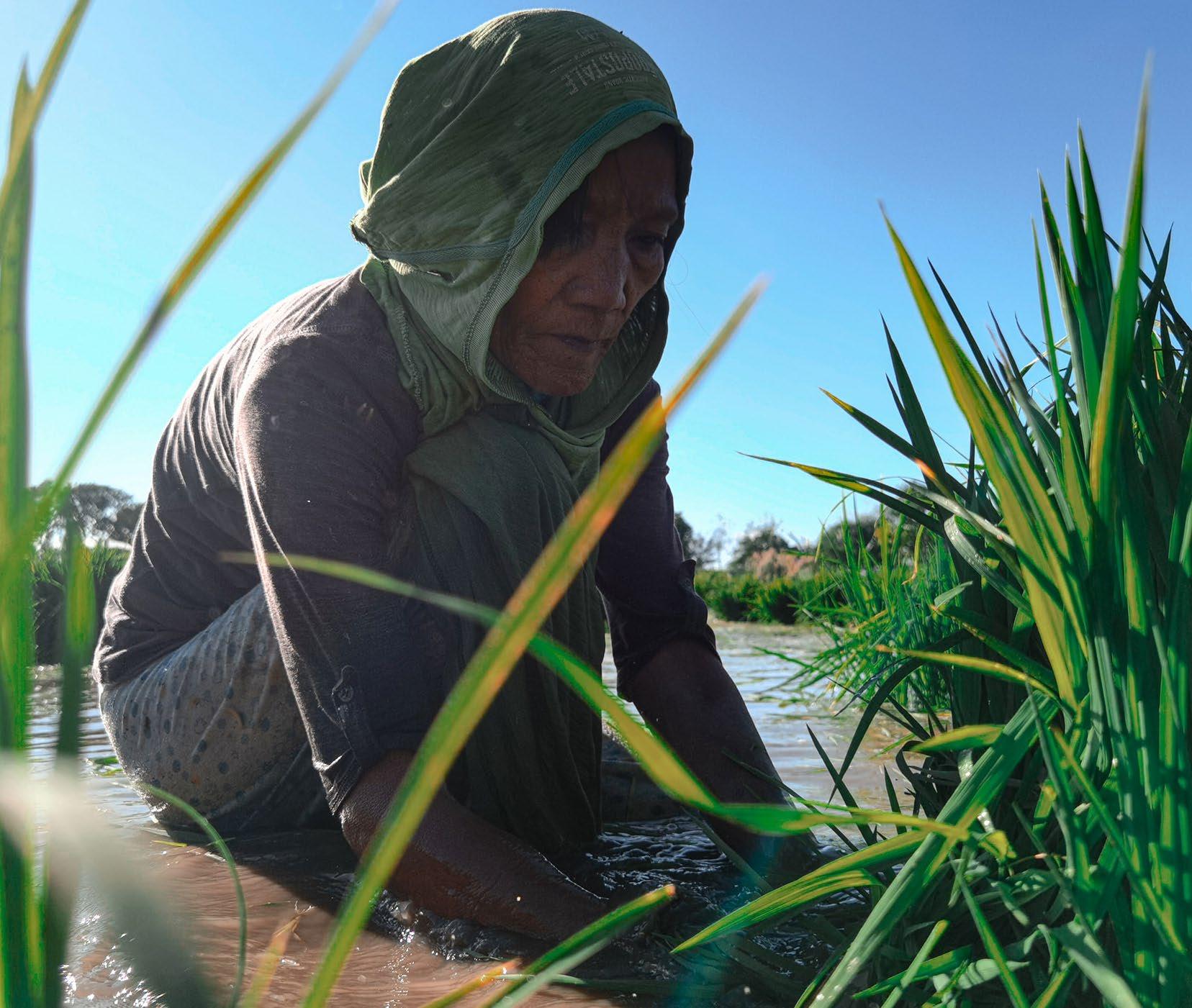

farmers' profit margins, leaving them less incentive to produce more. Upgrading infrastructure would benefit farmers by reducing costs and enabling them to reach markets with better-quality produce.
On the other hand, some may claim that importing rice is necessary to ensure food security, especially as the population grows and the effects of climate change threaten domestic production. They may point out that imports provide a buffer to stabilize prices and supply during difficult times.
Christian A. Barrozo, Kenneth Carl Llamas, Cindy D. Tandoc, Dianne R. Manaois, Michael J. Garcia, and Aliah Joice G. Garcia, who guided the students through the clean-up. Also in attendance was Ms. Jane Ramirez, Head Teacher III, and other science teachers from the elementary and secondary levels.
Their involvement highlights the school’s commitment to environmental education as a core part of its curriculum.
With the support of School Principal IV, Dr. Reymond N. Villare, ECIS could effectively mobilize its students and teachers for the clean-up drive.
Dr. Villare's leadership and encouragement were crucial in ensuring the event's success, highlighting the school's dedication to environmental advocacy.
The clean-up served as a reminder of the importance of keeping the coastlines clean and ensuring that future generations enjoy a healthy and thriving country’s megadiversity.
While there is truth in these arguments, they miss the point. Dependence on imports leaves us vulnerable to global market fluctuations, and relying on imports for our staple food weakens national food security. Instead of focusing on shortcuts, the government must invest in real solutions to uplift the agricultural sector and support our farmers. Irrigation systems must be improved to ensure a consistent water supply for rice paddies. Then, more subsidies and technical support should be given to farmers to help
them increase yields and reduce costs. Also, infrastructure must be developed to help farmers transport their produce more efficiently, ensuring their harvests reach markets in good condition.
We should no longer accept that our agricultural sector, once thriving, now lags behind.
We must focus on revitalizing it so future generations will not have to grow up singing that planting rice is never fun but instead take pride in an agricultural heritage that truly feeds the nation.
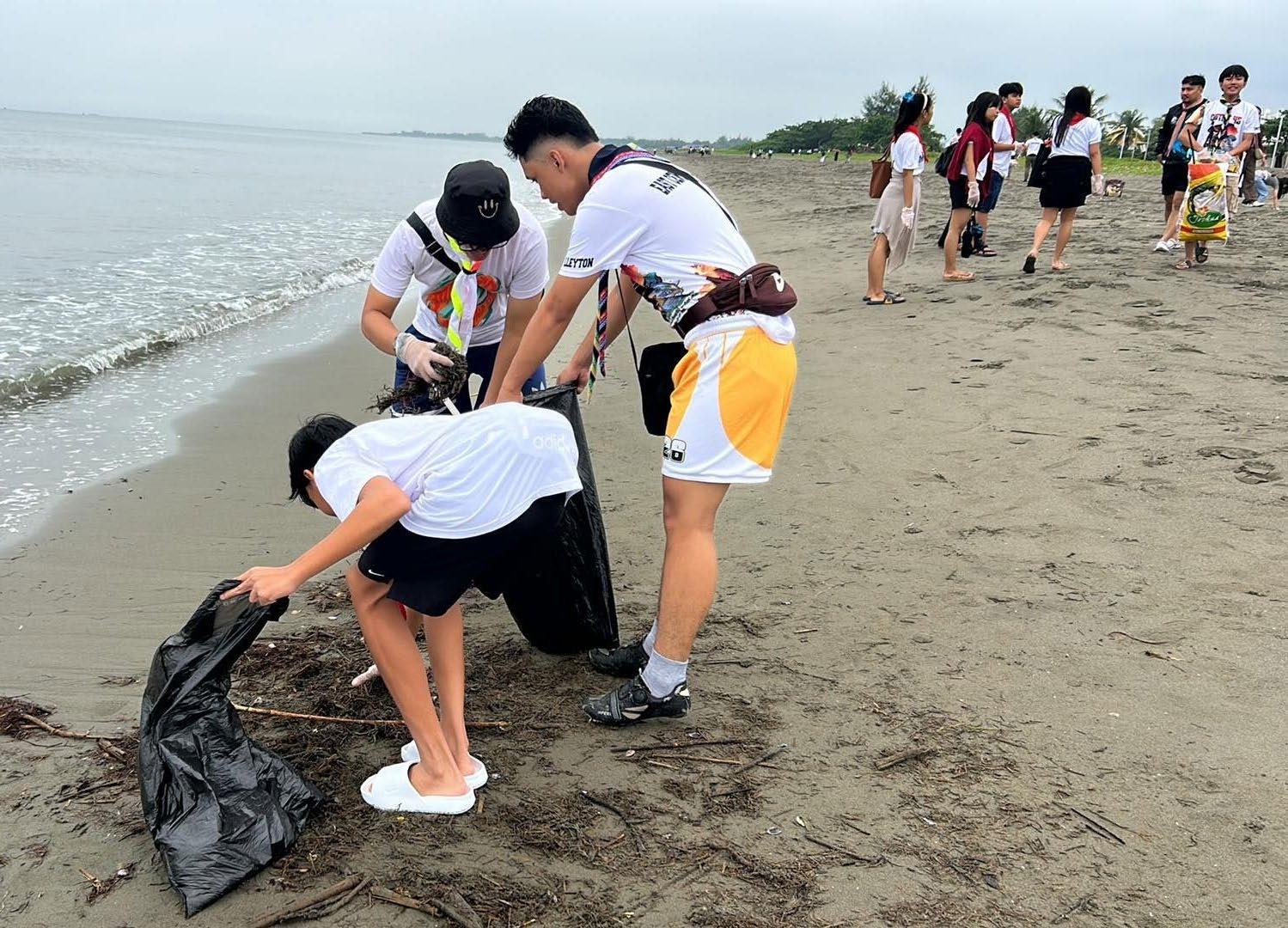

arcoma is one of those kinds of cancers that most people know little to nothing about. It is often neglected in discussions about cancer, which makes it even more serious. Why is sarcoma so unknown? Did you know that sarcoma can be fatal if not detected at the right time? To answer these questions, it's essential first to understand what sarcoma is and how it affects the body.
Sarcoma is a rare malignant tumor that typically forms in the bones or connective tissues, including fat, muscle, blood vessels, and nerves. Sarcoma is so rare that only about 1% of adult cancer patients, or approximately 15% of children with cancer, develop the condition (Cleveland, 2022). An estimated 16,000 new cases are diagnosed every year in the United States, with around 4,000 being bone sarcomas and approximately 13,000 being soft tissue sarcomas. Early detection can be challenging because sarcoma can arise almost anywhere in the body. Although sarcoma can affect anyone, certain kinds are more likely to occur at particular stages of life. For example, soft tissue sarcomas are most often found in adults, while bone sarcoma tends to affect children, teenagers, and those over 65. Bone sarcomas also occur more frequently in males and among Black or Hispanic individuals.

By: Dannica De Vera
everyone in 2024 when he announced his sarcoma diagnosis. Pressures from campaigning and dealing with public criticism affected his health. By the time he started experiencing symptoms, the condition had already worsened.
A visit to the doctor revealed a massive 16 cm tumor inside his stomach, which was blocking his esophagus, making it difficult for him to swallow. The doctor described it as one of the largest, fastest-growing, and most hidden sarcomas. Doc Willie’s story became instrumental in raising awareness about the importance of regular health check-ups, even when life gets too busy or stressful.
Sarcoma on Patients Sarcoma is truly life-changing for cancer patients. It can throw what was once an ordinary life into chaos, filled with battles against painful symptoms, difficult treatments, and uncertain outcomes. Treatments like chemotherapy or surgery often lead to a challenging and exhausting journey for patients. Due to its rarity, sarcoma often goes undetected initially, even by doctors, making early diagnosis difficult. The tumors tend to form in hidden areas, leading to many patients only finding out about their condition after it has already progressed significantly.
A Reminder to Prioritize Health
Doc Willie Ong’s experience is a powerful reminder of why health should always be a priority. Attention to unusual changes in the body and seeking timely medical attention is crucial. Despite sarcoma being a rare type of cancer, its effects can be deadly. Timely diagnosis can significantly improve a patient's chances of recovery. Sarcoma reminds us all that even easily overlooked health issues can turn into severe and life-threatening conditions if not addressed promptly.


By: Greg Ryan So
Aiming to boost stu-
dents' mathematical proficiency, East Central Integrated School, under the leadership of School Principal Dr. Reymond N. Villare, has joined a recent partnership between the Department of Education (DepEd) and Khan Academy.
DepEd signed a memorandum of agreement (MOA) with Khan Academy, a globally recognized non-profit organization that offers free education in various subjects, including mathematics, science, reading, and computer programming.
This partnership will focus on improving math skills among Filipino learners using the Khan Academy platform, which features instructional videos and practice
exercises designed for Grades 7. DepEd Secretary Sonny Angara hailed Khan Academy as an exceptional tool that enhances student learning and supports parents and teachers.
"This will definitely help us in our PISA performance, if not by 2025, then by 2029, as the tool is well-adapted to each learner's needs," Angara stated, expressing optimism about the initiative's impact.
In the 2022 PISA results, the Philippines ranked among the bottom 10 out of 81 participating countries in mathematics, reading comprehension, and science.
Angara believes that these standings can be significantly improved with the help of Khan Academy.
Dr. Reymond N. Villare, Principal of East Central Integrated School, echoed these ideas,
stressing the importance of utilizing innovative tools to bridge learning gaps in mathematics.
"We are very positive that our learners would be very interested in terms of attending their classes, especially that it is very interactive. We will be using our technology, and they’ll be learning mathematics while having fun using it," Dr. Villare said.
Khan Academy aims to benefit one million Filipino learners by 2028, making it an instrumental partner for the Philippine educational system.
The introduction of Khan Academy at East Central Integrated School signifies a proactive approach towards fostering a culture of learning and resilience in mathematics, preparing the students of Dagupan City for future challenges and opportunities.

By: JB Parohinog
The use of artificial intelligence (AI) tools among students for research purposes is on the rise, according to a recent survey conducted by Grade 12 HUMSS students from East Central Integrated School on August 12September 12.
The survey, which involved learners from Grades 10, 11, and 12, highlighted how AI has increasingly become a valuable resource for students in generating written outputs and conducting research.
The survey gathered insights from students from different grade levels to understand the prevalence of AI use in their academic activities.
The findings revealed that 72% of Grade 12 students used AI in completing their research work, while Grade 11 learners showed a similar trend, with 68% acknowledging the use of AI tools for their academic outputs. Meanwhile, 60% of Grade 10 students reported using AI to assist their research and writing tasks.
This trend points to a significant shift in how learners approach research, indicating their readiness to embrace new technologies to enhance productivity and learning outcomes.
Many students reported that AI tools helped
them refine their writing, gather relevant information faster, and structure their arguments more clearly.
Rufino Martinez, a student from Grade 11, noted, “AI has made it easier for me to access information and organize my ideas more efficiently.”
Despite the positive outlook, the survey also raised questions about the potential pitfalls of relying too heavily on AI, including concerns over academic integrity and the importance of nurturing critical thinking skills.
Teachers at East Central Integrated School expressed cautious optimism, emphasizing the need to balance AI usage with the development of independent research skills.
“AI is a fantastic tool if used properly. However, we need to ensure that students also develop their critical thinking skills and do not rely entirely on technology for their work,” said Daniel Bravo, a Grade 12 HUMSS teacher.
The survey results reflect a worldwide trend as education systems increasingly integrate AI technologies into learning environments.
The school seems to be finding ways to balance the benefits of AI with the traditional learning approaches, pointing toward a future where technology and human intellect go hand in hand.


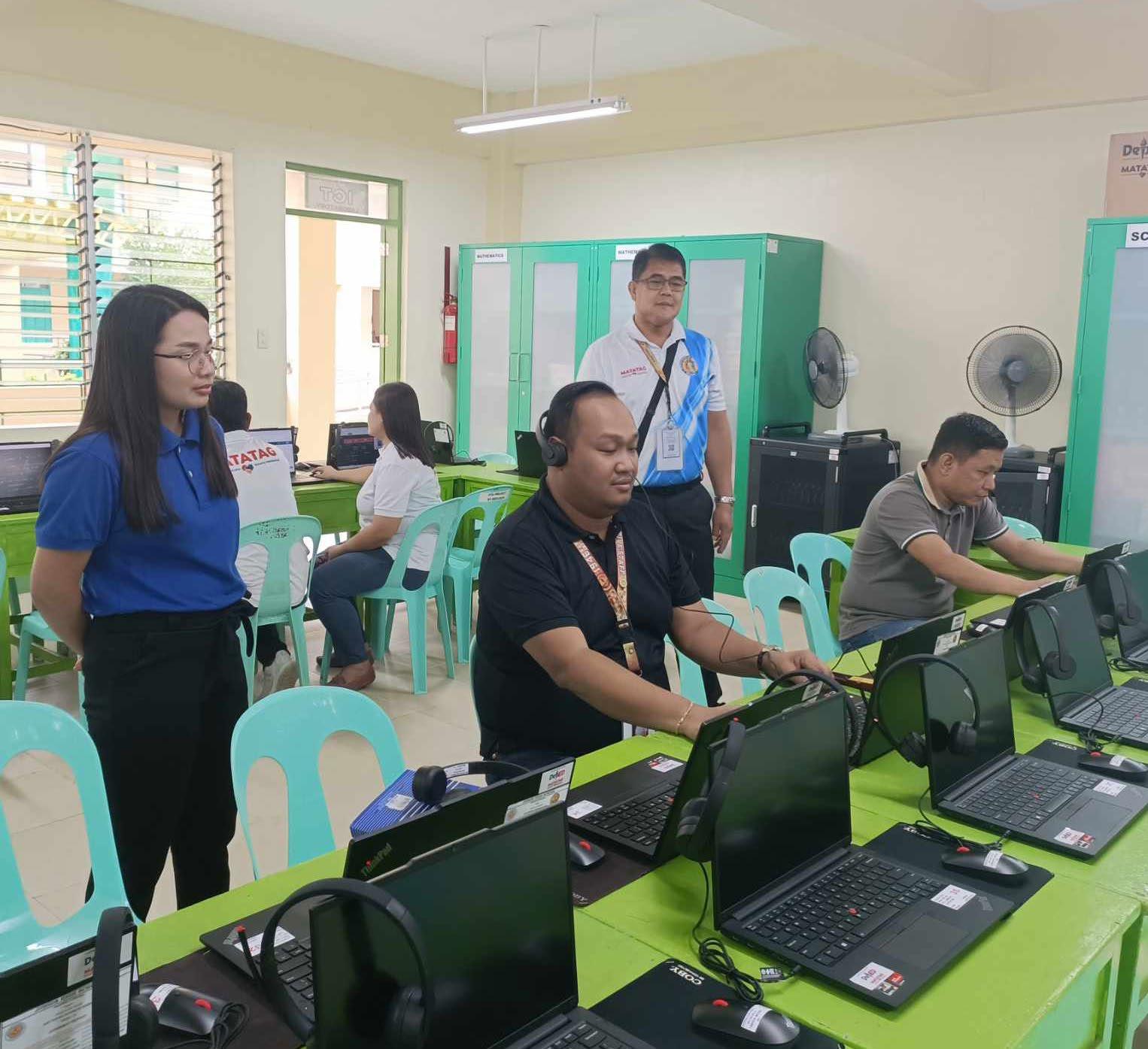


By: Lawrence Viray
Around 40% of households in the Mayombo area with school-aged learners—equivalent to two out of every five students—lack a high-speed internet connection, putting these students at a significant disadvantage when completing their homework.
This finding comes from a study conducted by STEM 11 students, highlighting the persistent issue of the digital divide.
The lack of broadband access particularly affects school-aged learners from lower-income households.
Approximately one-third of households with learners aged 12 to 18, whose annual income is below 30,000 pesos, do not have access to highspeed internet at home.
In contrast, only 6% of households earning 75,000 pesos or more face similar challenges.
This disparity is especially pronounced in three barangays near the school, where low-income households with school-aged learners are concentrated.
“This is a problem for most of the students here, especially for low-income families,” said Delan Ballesteros, STEM 11 proponent of the study.

By: Rhainny Dimaapi
Dagupan City has once again proven its commitment to environmental protection and sustainability, receiving the prestigious title of Best Environmental Partner from the Department of Environment and Natural Resources (DENR) in the recently concluded “GAWAD KALIKHASAN” Philippine Government Month 2024 on July 22.
On behalf of Dagupan City, Mayor Belen Fernandez graciously accepted the award, accompanied by key figures instrumental in the city’s environmental programs: Atty. Gil Aromin, Environmental Programs Consultant, and Bernard Cabison, Chief of the Waste Management Division.
The recognition highlights Dagupan City's exemplary collaboration with the national government in implementing various environmental initiatives and projects to protect the environment and conserve natural resources.
In her acceptance speech, Mayor Fernandez emphasized that the success of Dagupan’s environmental programs was a collective effort.
“Also, with the help of our Engineering Office led by Engr. Josephine Corpuz and
The study described this form of digital inequality as the "homework gap," a term highlighting the academic challenges faced by students who lack access to digital resources at home.
High school learners from lower-income households are more likely to face these difficulties.
According to a survey conducted between September 7 and October 10, 2024, involving 243 students aged 12 to 18, the "homework gap" is a widespread problem.
Overall, 17% of students reported that they are often or sometimes unable to finish assignments due to unreliable access to a computer or internet.
In some cases, students who lack reliable internet service at home resort to using public Wi-Fi for schoolwork.
About 12% of teens said they sometimes use unreliable public Wi-Fi to complete assignments because they don't have internet access at home.
“Minsan nakiki-hotspot nalang ako sa mga classmate ko na may load,” one student shared.
Additionally, 35% of students reported frequently completing homework on their cell phones.
While using a cell phone for assignments is not uncommon, it is especially prevalent among lower-income students.
she emphasized on her Facebook page.
She also recognized the barangay officials, youth leaders (Sangguniang Kabataan), frontliners, and non-governmental organizations (NGOs) actively participating in the city’s efforts.
One of the most notable efforts that contributed to this recognition is removal of illegal structures along the coastlines of Bonuan Binloc. This significant environmental action restored the cleanliness and order of the area organized by City Legal Officer Atty. Aurora Valle through Executive Order No. 2 or “Creating and Organizing Foreshore Regulatory Commission of the City of Dagupan.”
As Dagupan City sets a strong example for other local government units, it remains committed to creating a greener, cleaner, and more sustainable environment for future generations.
Through collaborative efforts, proactive policies, and community involvement,


By: Ken Macaraeg
Like many cities across the Philippines, Dagupan has seen a surge in vape shops popping up across the area to cater to a growing market. Despite existing laws that strictly prohibit smoking products among minors, the prevalence of e-cigarette usage or "vapes" is escalating among individuals aged 13-15. The Global Youth Tobacco Survey (GYTS) revealed that 14.1% of Filipino students have embraced vaping.
E-cigarettes, also known as vapes, are battery-operated devices that heat a liquid to produce an inhalable vapor containing nicotine, chemicals, and various flavors. Although they resemble traditional cigarettes, they do not burn tobacco, making them part of electronic nicotine delivery systems (ENDS). However, according to the Centers for Disease Control and Prevention (CDC), e-cigarettes contain harmful heavy metals and ultrafine particles that can damage the lungs and other vital organs.
Influence on the Youth A student using the pseudonym Angel Baby, shared his perspective on vaping during an interview. "Hindi naman masakit pero kapag nasobrahan, nakakahilo. Nicotine rush daw ang tawag doon. Kapag nahilo ako nang sobra, natutulog na lang ako" Angel explained, indicating that while

vaping does not seem painful, overuse can cause dizziness. E-cigarettes are highly addictive because their primary ingredient, nicotine, is particularly harmful to the developing brains of teenagers.
The National Institutes of Health (NIH) reports that 30.7% of e-cigarette users eventually begin using traditional tobacco products like cigarettes, cigars, and hookahs, highlighting the risk of vaping as a gateway to other addictive substances. The CDC also links vaping to severe lung injuries, including EVALI (e-cigarette, or vaping, product use-associated lung injury), which can lead to fatal symptoms like coughing, shortness of breath, chest pain, and fatigue.
Widespread vaping among teenagers often stems from misconceptions about its safety and the belief that it is a less harmful alternative to smoking. In 2021, the Truth Initiative found that 50.3% of regular vapers used vaping to cope with




stress, with 45% endorsing it as a stress relief method. On the other hand, 47% of teens who quit vaping reported feeling a greater sense of control and experiencing reduced stress, anxiety, or depression.
Community Response Health officials in Dagupan City, led by local advocates, firmly reject the notion that vaping is a safe alternative to smoking. In 2019, the DOH prohibited the use of e-cigarettes and vapes in public places. Republic Act 11467 already prohibits the sale of vapor products and heated tobacco products to individuals under the age of 21. Despite these regulations, the GYTS also found that it remains easy for Filipino students to purchase tobacco products, with 37% of current smokers stating that it was easy for them to do so, regardless of their age.
uan lay in bed, flushed with fever, his breath heavy and erratic. Aling Felisidad, his mother, watched over him with worried eyes. After days without improvement, she decided it was time to call Mang Siyenso, their local healer. "Mang Siyenso has helped my neighbors before; I don’t have money for a hospital. I have faith in him,” she said, gripping her rosary as though each bead held its remedy.
In the Philippines, folk healers like Mang Siyenso are woven into the social fabric, a legacy from our ancestors that has survived through centuries. For many Filipinos, especially in rural areas, folk healers— locally known as albularyos—aren’t just an affordable health option but a tradition-bound to their heritage. This cultural reliance brings comfort and risk, leading to important questions about how faith healing affects Filipino health today.
The Roots of Tradition
Long before the Spaniards colonized the Philippines, Indigenous Filipinos held strong beliefs in supernatural causes of illness, often blaming sudden ailments on "pasma" (thought to be caused by temperature changes) or curses and malevolent spirits. Showing respect for unseen creatures through phrases like "tabi-tabi po" remains common today. Additionally, the traditional healer known as the babaylan—a spiritual guide, a doctor, and a mediator—was believed to bridge the physical and spiritual worlds, offering healing remedies steeped in nature and the supernatural.
“People come to me because they believe, not just because of what I can do,” Mang Siyenso said as he poured rice grains into a small bowl. “This is our way. The body and spirit are connected.” Aling Felisidad nodded in agreement, her fingers tracing the woven patterns on her blouse as she spoke. "We have always believed in the power of nature and prayer," she added.
While deeply rooted in tradition, such practices can complicate the healthcare landscape, leading to a reliance on faith-based healing where medical treatments may otherwise be more effective.
Healing or Harm?
Albularyos offer a form of psychological comfort— often classified in psychology as the “placebo effect”— wherein patients feel better simply because they believe in the treatment they’re receiving. This trust can indeed result in relief, especially for ailments that may resolve over time. “When Mang Siyenso prays and waves his hand over me, I already feel lighter. It’s like my sickness leaves me,” shared one of his regular clients.
Teenagers may be misled by vape shops and companies, believing that once they turn 18, vaping becomes legally permissible. However, the reality is different. "Minsan nakalagay na 18 years old pataas lang ang pwedeng bumili. Pero hindi na chine-check ang ID.” Angel Baby affirmed, noting that many vape stores in Dagupan do not strictly check identification, allowing minors to access such products easily.
Both smoking and vaping practices raise significant public health concerns and are highly discouraged. The allure of flavored vapes may entice some, but the addictive nature of nicotine and the potential for severe lung injuries make vaping just as detrimental as traditional smoking. Local communities, academic institutions, and authorities in Dagupan must collaborate closely because current laws alone are insufficient to eradicate substance abuse.
Yet, without scientific evidence backing these methods, there are inherent risks. "There are cases when folk healing provides no cure or even makes things worse," said Dr. Maria Ramirez from the Philippine Department of Health. "While some ailments are minor and may improve naturally, severe illnesses need medical intervention. Sadly, folk healers can delay critical treatments."
In response to these concerns, the Department of Science and Technology (DOST) launched a program to work alongside healers, hoping to integrate scientifically verified treatments with traditional methods. In collaboration with the Philippine Institute for Traditional and Alternative Healthcare (PITAH), the program studies the use of herbal remedies and rituals that have endured for generations. “By understanding the science behind these practices, we aim to find real value while also ensuring public safety,” Dr. Ramirez explained. Can Tradition and Science Coexist?
Many Filipino medicinal plants, such as lagundi for cough and asthma, sambong for kidney stones, and herba buena for pain, were first popularized by folk healers in rural areas. The PITAH-DOST collaboration aims to validate and expand on these traditional remedies, potentially uncovering new treatments for various health issues. “We want to bridge the gap between tradition and science," stated Dr. Lourdes Velasquez, a researcher with PITAH. "We may find answers to conditions we currently struggle to treat with modern medicine."
This initiative holds promise, especially for rural and economically challenged communities. Rather than disregarding traditional practices, researchers are now exploring how these methods might complement modern healthcare.
The Truth Beyond Belief
As Aling Felisidad gently stroked Juan’s forehead, her expression softened. “I believe in Mang Siyenso, but I also want what’s best for my child,” she confessed. Like many Filipinos, Aling Felisidad is torn between cultural loyalty and the allure of modern medicine. For now, the effectiveness of folk healers remains a matter of faith more than fact. But through the DOST-PITAH partnership, science and tradition may yet find common ground. This collaboration represents a shift toward understanding the broader effects of folk healing—not to debunk it but to see if it truly offers the relief so many seek.
As the age-old battle between belief and knowledge unfolds, the question lingers: in our faith, do we find healing—or do we risk harm? Only science can provide the answer, but the spirit of tradition lives on in every albularyo’s humble hut, every patient’s hopeful prayer, and every mother’s love.

By:
DAGUPAN CITY — Joshua Capua, a Grade 12 East Central Integrated School (ECIS) student, is poised to lead his basketball team to victory in the upcoming Dagupan City Athletic Association (DCAA) games this December.
Capua, who has shown exceptional skills throughout the season, is expected to be a key player in their quest for the championship.
The ECIS basketball team has been training intensively, with practices held every day after class hours.
Russel Bugayong, Junior High School Sports Coordinator, expressed his confidence in the team’s readiness for the competition.
“We have a solid team this year, and Joshua’s leadership on and off the court is a big factor,” Bugayong said. “He’s not just a skilled player; he knows how to bring the best out of his teammates,” Bugayong said.
Capua, who serves as the team's captain, has been instrumental in leading his teammates through rigorous practices and maintaining high morale.
“We’re ready to give it our all,” Capua said. “Our goal is not just to play well but to win for our school and our community. We’ve worked really hard for this, and I know we can do it,” Capua said.
The DCAA games have always been a highly anticipated event in Dagupan City, bringing together the best athletes from various schools to compete for the coveted title.
With Capua at the helm, ECIS’s basketball team is expected to be one of the top contenders.
“Joshua’s dedication has been amazing. He’s an inspiration to the younger players and a leader we can all count on. The whole school is behind them, and we’re excited to see them take the court in December,” Justine Estaris, one the ECIS basketball team members.
The community's support has been evident as they rally behind their young athletes, with everyone looking forward to an exciting and competitive tournament.
All eyes will be on Capua and his team as they strive to bring the championship trophy back to East Central Integrated School.

By: Lawrence Viray
I
n the heart of Dagupan, East Central Integrated School (ECIS) has embraced traditional Filipino games, known as Laro ng Lahi, to foster sportsmanship and camaraderie among its learners.
These traditional games have become integral to the school’s culture, shaping students' character and instilling values beyond the playing field. Including Laro ng Lahi has enhanced physical activity and cultivated a spirit of cooperation, respect, and inclusivity among the students.
Laro ng Lahi, deeply rooted in Filipino culture, features a variety of traditional games like patintero, luksong tinik, piko, and sipa. These activities require team-
work, strategic thinking, and fair play— crucial for nurturing sportsmanship.
Through these games, students learn to appreciate teamwork, respect for others, and the graceful acceptance of victory and defeat.
Mr. Roan Jett Fernandez, Head Teacher of ECIS, strongly advocates for integrating Laro ng Lahi into school programs.
"Through these traditional activities, we aim to foster camaraderie, fair play, and discipline among our students. These are the values that will help them succeed not only in sports but also in life," he said.


The impact of Laro ng Lahi on ECIS is evident in how students across different grade levels come together to participate. These games transcend social barriers,

allowing learners to form friendships and build bonds beyond the classroom.
For 14-year-old Janna, a Grade 8 student, Laro ng Lahi has changed her perspective on teamwork and sportsmanship.
"Playing traditional Filipino games taught me to work with my classmates and respect the rules," she says. "It’s not about winning; it's about playing fairly and having fun with my friends," she said.
The enduring impact of Laro ng Lahi stands as a testament to the transformative power of traditional Filipino games. These activities not only enrich students' lives by instilling sportsmanship and cultural pride, but also nurture a generation that values cooperation and embodies the best of Filipino traditions.


By: Chris Alfred Distor
East Central Integrated School (ECIS)
chess prodigy Ashlyn Joy L. Po was among the select young athletes from various public and private schools invited by the Youth and Sports Development Program of the Dagupan City Sports Commission (DCSC) to showcase her exceptional chess skills at the on October 3, 2024, an event held in CSI Stadia, Jimmy L. Fernandez, Lucao District, Dagupan City.
Ashlyn, a Grade 10-Bernal well-known for her extensive knowledge of the game and stellar record, took center stage and showed off her skills in several exhibition bouts. The crowd and the event organizers praised her for her strategic plays and ability to outmaneuver opponents.
Ashlyn's standing in the local chess community, where she continues to motivate new chess players, is highlighted by this invitation. Ashlyn's presence gave the display more significance, and it was a part of the DCSC's larger initiative to encourage youth participation in sports. In the most recent DCAA Sports Competition in 2023, she placed fourth out of all her competitors.
“We’re incredibly proud to have Ashlyn represent ECIS and Dagupan. Her dedication to chess is a testament to what young athletes can achieve,” said a City Youth and Sports Development Program spokesperson. Ashlyn Po's participation in this event marks another significant turning point in her nascent chess career and solidifies her position as a rising star in Dagupan's youth sports scene.
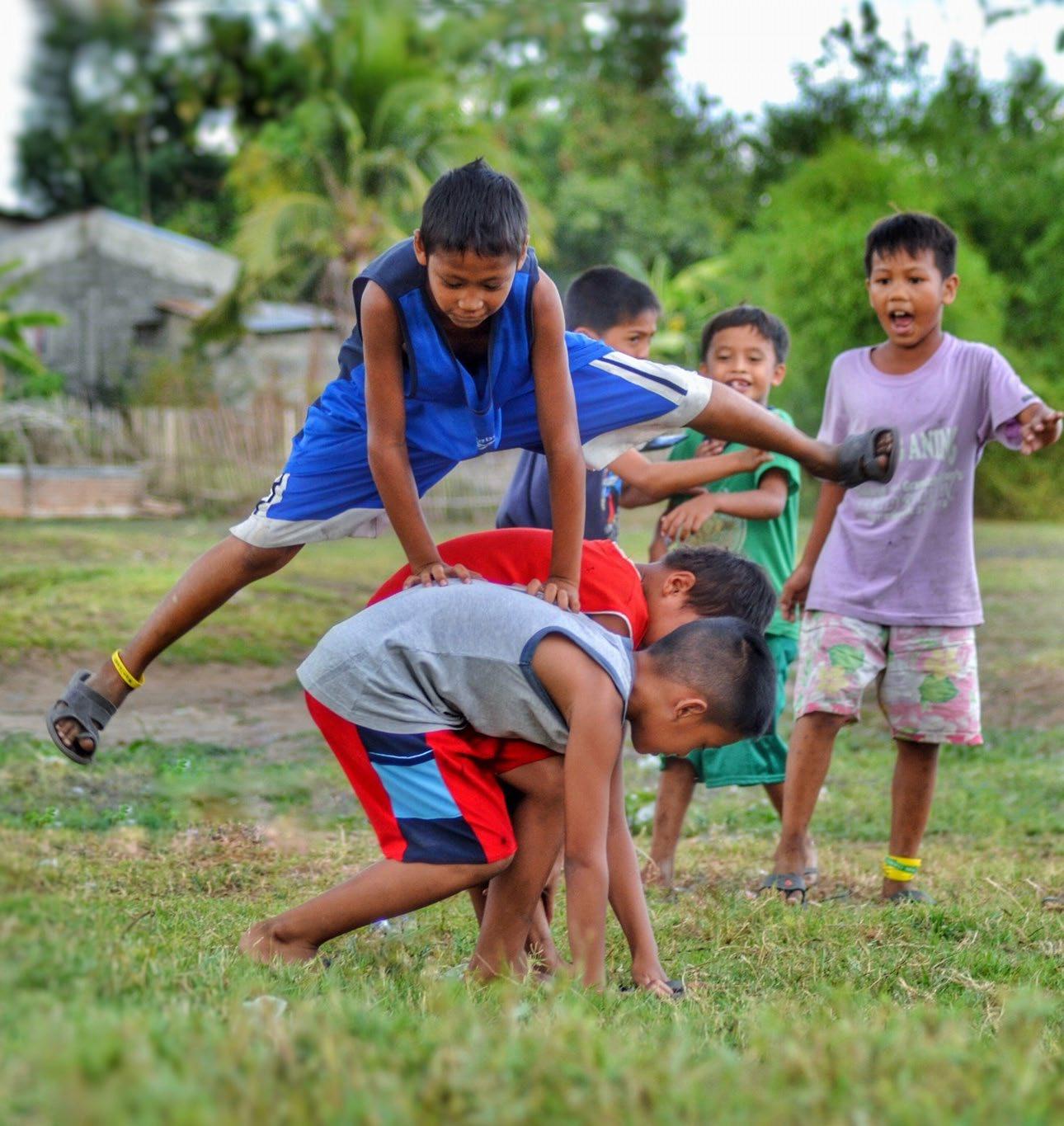


By: Chris Alfred Distor
Many young Filipinos are enthralled by Carlos Yulo's remarkable performance, which earned him two gold medals. His triumphs coincide with the 100th anniversary of the Philippines' Olympic participation. East Central Integrated School students from various sports expressed their opinions on this milestone and the importance of Yulo's accomplishment.
"Carlos Yulo is a true inspiration," said Vince Gabriel, a Grade 10-Celerio student who does gymnastics same. “I love how he broke barriers for gymnastics in the Philippines. We don’t have much attention on this sport, but he’s shown that we can reach the top with hard work. It makes me want to push beyond my limits, not just in sports but all life aspects.”
For Nhyjel Espinoza, an 11-SMAW student and a football athlete, Yulo’s victory resonates deeply with persistence. “What I admire about Carlos Yulo is how he keeps pushing himself despite setbacks," Nhyjel said. “He didn’t win as much in previous competitions, but he kept going. That’s the lesson I’ll take with me—never give up, no matter how tough things get."
Another student, futsal enthusiast Karylle Carla Raguindan , Grade 12-HUMMs sees Yulo as a symbol of hope for aspiring athletes.
“He’s proven that Filipinos can be champions in sports that aren’t mainstream here," she explained. “We always hear about basketball or volleyball in school, but now, we view gymnastics as a real possibility. Yulo’s win might inspire more schools to support these ‘less popular’ sports.”
For Steven Clyde Golez, a 9-Amorsolo student who plays chess with dreams of competing internationally, Yulo’s achievements on the global stage have a deeper personal meaning. “It feels like we are part of something bigger,” Steven shared. “We’ve been in the Olympics for 100 years, and Carlos Yulo winning during this centennial year just shows how far we’ve come as a country. As someone who dreams of competing internationally one day, it gives me hope that I can represent the Philippines, too.”
Other students also highlighted the historical significance of Yulo’s wins. “This year is extra special because it’s not just about the medals,” said Zayin Jhay Ulani, a Grade 9 student whose sport is volleyball. “It’s about celebrating a century of Filipino athletes competing
in the Olympics. Carlos Yulo’s golds symbolize all the progress and challenges our athletes have faced for the past 100 years.”
A long-distance athlete echoed this sentiment, Ezra Cerezo, a Grade 10-Bernal student, who said, “To see a Filipino gymnast winning two golds in an event that celebrates our country’s 100th Olympic year is such a powerful moment. It’s a reminder that we can achieve so much when we keep going.”
Yulo’s victory is also a source of national pride for many students. “I’ve never felt more proud to be a Filipino,” remarked taekwondo jin Princess Culbengan. “Carlos Yulo makes us believe that no dream is too big. Even if we don’t always have the same resources as other countries, we can still come out on top. I think that’s the best lesson of all.”
As the Philippines celebrates a century in the Olympics, Yulo’s historic victories serve as a beacon of hope, showing that the next generation of Filipino athletes has the potential to reach new heights. His journey and triumphs inspire students to chase their dreams with passion, determination, and resilience.


East Central Integrated School (ECIS) celebrated the grand opening of Palarong East Central on October 11 in its Multi-Purpose Hall with a loud bang as the whole school community erupted in jeers and cheers.
The morning of the opening day was abuzz with excitement as a grand parade featuring the school’s Drum and Lyre Corps kicked off the festivities. The parade showcased six team units from the students and eight from the teaching and non-teaching personnel. Each was bedecked in vibrant colors, making it easy for onlookers to distinguish them, and creative banners were held by their beauteous Adonis and Muse.
The formal commencement of the event included introductory preliminaries, such as the singing of the Philippine National Anthem a prayer, followed by the hymn of the SDO-Dagupan. Students and teachers alike share together as they lit the urn in keeping with tradition, symbolizing a borderless society and the quest for peace and unity.
Sir Reymond Villare hyped the crowd with his welcome remarks, followed by the inspiring messages from Schools Division Sports Coordinator Dr. Liezl Cancino, EPS in MAPEH, Dr. Sheryll Villacorta, and PTA President Mr. Rodel Ramos expressing their hopes for an intramural filled with camaraderie and enjoyment. The students, led by Gabriel Vince Aquino,
a 2023 R1AA Bronze medalist in gymnastics, recited the pledge of sportsmanship, emphasizing the importance of fair play and mutual respect.
The thrilling entry into the world of sports kicked off with preliminary events, including team yells, banner raising, balloon flying, and a lively dance contest. Team leaders energized their groups by releasing their balloons, while the powerful team yells echoed the enthusiasm of each spirited unit, ready for the upcoming competitions.
The festivities flowed into the afternoon as eager participants from teaching and non-teaching staff competed in various sports, such as basketball, volleyball, and badminton, all under the guidance of officiating officials.
With the successful opening ceremony, the sports week is now officially underway. Organizers encouraged everyone to carry the spirit of camaraderie throughout the event, playing with passion, and sportsmanship and, above all, fostering fun and unity among all participants.



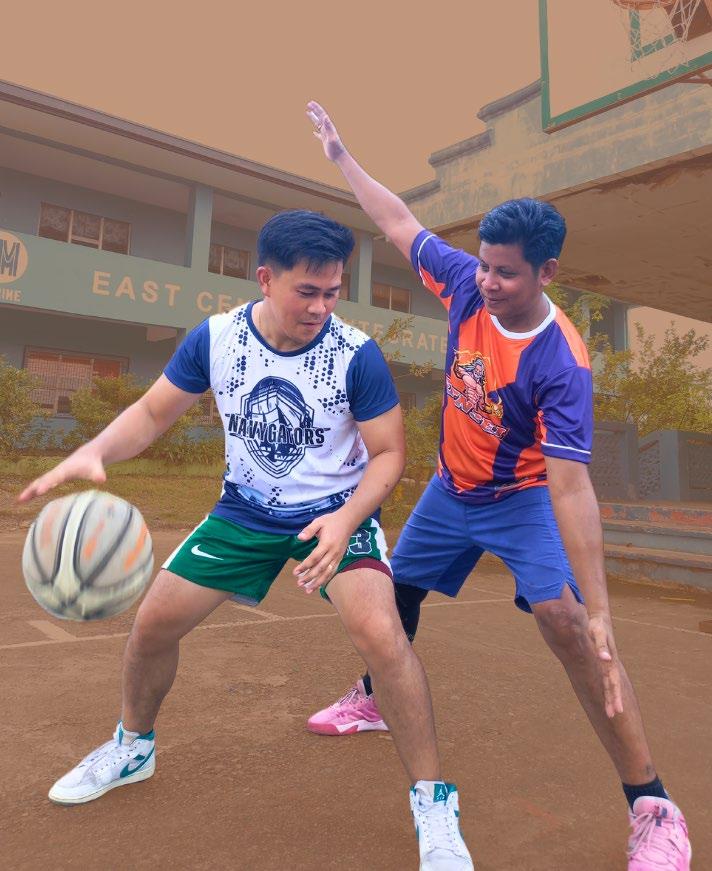
ne of the most exciting parts of being a student is experiencing the euphoria of cheering for your school as it competes against others in sports. The energy in the crowd is electric, but imagine being one of those student-athletes on the field or on the court. Student-athletes are often seen as the heroes and pride of a campus, raising the school's name and fostering a sense of community.
Instilling pride in their respective schools is an expectation and a responsibility, as students and teachers look up to them as symbols of athletic excellence. But as they carry the weight of their titles, win or lose, have we ever truly put ourselves in their shoes?

By: Lawrence Viray
Baguio City – The Schools Division Office of Dagupan City (SDO Dagupan) actively participated in the National Training of Sports Club Facilitators on the Teaching of Sports Specific Skills held at Teacher's Camp, Baguio City from October 21-25, 2024. This training is part of the Department of Education's (DepEd) commitment to foster holistic learner development through physical education.
The Bureau of Learner Support Service-School Sports Division (BLSS-SSD) organized the event to promote physical fitness, enhance health, and discover the sports potential of students. With a mission to strengthen sports clubs nationwide, this training brought together sports facilitators from different regions to enhance their skills and knowledge in sports coaching.
Dr. Edgar Timbol, head of the SDO Dagupan delegation, emphasized the importance of this initiative. “This is a great opportunity for all sports facilitators to share the knowledge they have gained from this training. Mas papalakasin natin ang sports club ng Dagupan City para sa mga magagaling nating athletes.” Timbol said.
The Dagupan City delegation participated the six
sports: Arnis, Pencak Silat, Dancesport, Table Tennis, Sepak Takraw, and Wushu. The Sports Club Facilitators who represented SDO Dagupan were: Arnis: Mary Zendy N. Ceralde, Dominic Velasco; Pencak Silat: Maridel M. Villanueva, Larry M. Bautista; Dancesport: Lizalyn Nabor, Joshua Bileg; Table Tennis: Widmark Balmores, Janielle Michu; Sepak Takraw: Mary Grace Quijano, Felimon Rivo; and Wushu: Babylyn Cervantes, Richelle
Buton
Mr. Joshua Bileg, a facilitator from East Central Integrated School who joined the Dancesport training, shared his experience. “Mahirap ang training pero dapat mas ahead ang mga facilitator para maituro ng maayos ang technicalities ng sports sa mga learners,” Bileg said.
In preparation for the upcoming Dagupan City Athletic Association (DCAA) competition, the sports club facilitators are tasked with conducting division-level re-echo sessions. These sessions will ensure that coaches and athletes across Dagupan City benefit from the advanced training and techniques learned in Baguio City, further boosting the competitiveness of Dagupan’s athletes.
This initiative underscores educators' vital role in teaching academic subjects and fostering a culture of physical excellence and sportsmanship among young learners.
Misconceptions About Student Athletes
Student-athletes are often expected to win as many games as possible, bringing glory to their district, city, provincial, or even national campus. Unfortunately, misconceptions abound about the academic side of their lives. Many believe that they receive special treatment from teachers, such as easier workloads or leniency with deadlines so that they can fulfill their academic requirements. However, behind the fame and the games they play, there lies a side of their story that often goes untold: the sleepless nights, the endless deadlines, the frustrations, and the constant pressure to balance sports and academics. Contrary to popular belief, student-athletes are some of the most diligent and hardworking students. Balancing academics and sports is
not easy, and they deserve recognition for their efforts. Student-athletes often speak of effective time management and setting priorities, tackling what is most important before anything else when asked how they manage their time.
The True Essence of Balance
Being a student-athlete requires determination and grit to balance sports and academics. Towering trophies, sparkling medals, and cash prizes are not the only rewards they gain. The real essence of being a student-athlete is learning how to effectively manage time and priorities, which are invaluable both on and off the field.
The determination to excel in academics and athletics truly sets student athletes apart, and it deserves our recognition and respect.



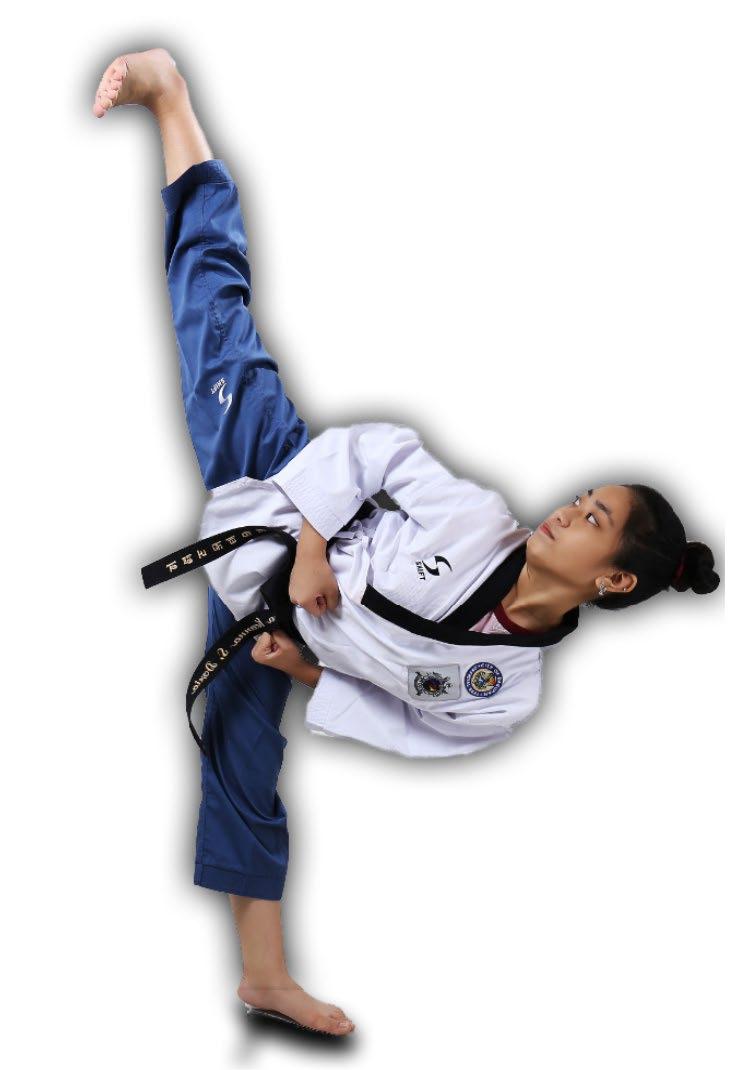

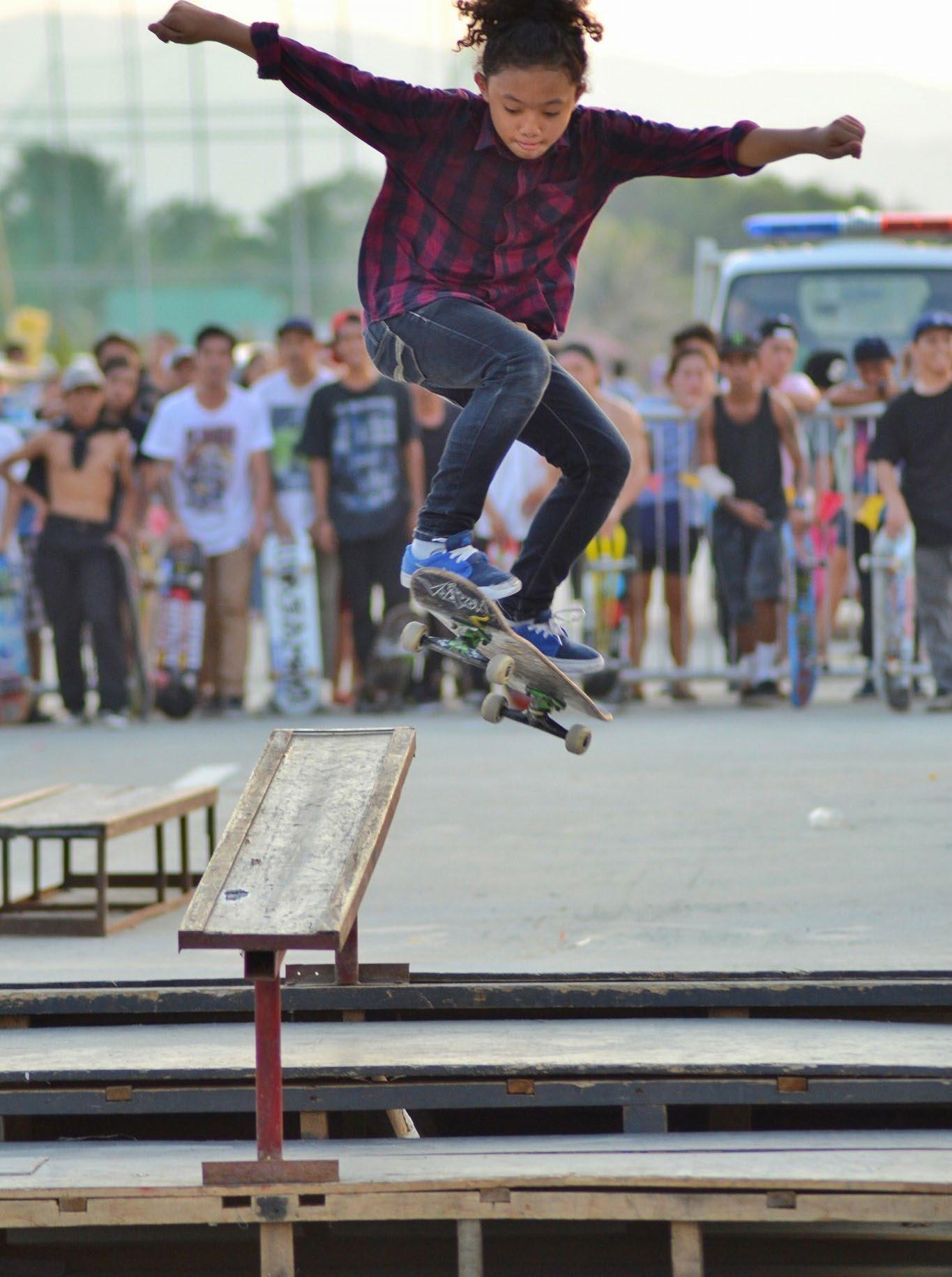


The East Central Integrated School (ECIS) gymnasium buzzed with excitement as students from Grades 7 to 12 competed in the much-anticipated Breakdancing Competition, part of ECIS’ Palarong East Central. Grade 12 emerged as champions with a standout performance blending athleticism, rhythm, and storytelling that captivated the audience.
Grade 10 claimed first runner-up with an energetic routine showcasing precision and stage confidence, while Grade 11 took second runner-up, impressing judges with their versatile mix of traditional breakdancing and modern dance elements.
The competition showcased ECIS’s deep pool of talent, with each team adding its unique style and creativity to the event. Judges commended all participants for their skill, dedication, and sportsmanship, noting the quality and passion evident in each routine.
Juguilon Takes Taekwondo Bronze, Concepcion Twins Compete in Gymnastics

By: Chris Alfred Distor
Janna Leah Juguilon of East Central Integrated School (ECIS) in SDO Dagupan City won a bronze medal in the Taekwondo Bantamweight Division (Secondary Girls) at the 2024 Palarong Pambansa in Cebu City. Her victory brings pride to her school and city, while fellow ECIS students Lara Faye and Lara Faith Concepcion also impressed in gymnastics, showcasing the school’s growing talent in sports.

agupan City, Pangasinan
- The city recently celebrated the success of its local skateboarders at the Pangasinan Go Skateboarding Day 2024, held on June 24, to promote sports and recognize local talent.
Aspiring skateboarder from East Central Integrated School, Clark Calma, shared his excitement about participating: “I did not compete but I want to become part of this incredible community.”
He added that events like this help him push his limits and make new friends who share his passion.
Another participant, Niel Santos, echoed this sentiment. “Skateboarding is more than a sport; it’s a way of life,” he said, describing the event as a unique opportunity for local talent to shine.
Moreover, the city council announced in the event the first public skate park to build in Pangasinan located in Da-
gupan’s Tondaligan Ferdinand Beach for commending the local skaters for their dedication and discipline.
Mayor Belen Fernandez supported this initiative together with the sports and tourism advisers from Pangasinan Skateboarding Community.
City Mayor expressed her excitement on this first ever public skate park in Dagupan.
“I also think that this skate park will be an added attraction to our beach. Marami ring manood and will be amazed just like me,” she said in her Facebook post.
The skate park is expected to be a space where local skaters can safely hone their skills.
As the designs are being finalized, skaters across Pangasinan can look forward to a spot that’s all their own, set against the attractive backdrop of Tondaligan Beach.

By: Chris Alfred Distor
The Blue Eagles continue to soar, showcasing their dominance in after-school sports competitions at the ECIS Multi-Purpose Gym, where teaching and nonteaching personnel battle it out in basketball, volleyball, and badminton.
For two weeks, the gym has been the stage for thrilling matchups, providing a refreshing outlet for stress and a fun way for colleagues to bond. Divided into teams, participants from all departments compete with intensity and spirit.
The Blue Eagles, known for their prowess, have particularly stood out in these competitions, displaying their mastery on the court.
Mr. Russel Bugayong, Sports Coordinator, remarked, “The Blue Eagles are not only excelling in the classroom but dominating in sports as well,” highlighting their skillful play.
As expected, basketball was the Blue Eagles’ strongest suit, with their precision in shooting and teamwork proving too much for their rivals.
Mr. Anthony Ayala, quipped, “When the Blue Eagles hit the court, it’s like watching a well-oiled machine.”
The Blue Eagles continued their winning streak in volleyball, outmatching the Orange Tigers and Red Lions.
Known for their agility and strategic play, the Blue Eagles
turned defense into offense repeatedly.
Mr. Joshua Bileg from Orange Tigers noted, “Their ability to read the game and adjust on the fly has been remarkable. Every spike and set is calculated.”
Meanwhile, in badminton, the Eagles once again asserted their dominance.
Their players’ quick reflexes and strategic shot placement ensured their position as frontrunners.
“Their badminton players have been flawless, making it difficult for the Tigers and Lions to keep up,” said Mrs. Filipina Calaunan.
While the friendly rivalry remains, the ECIS community has been united through these games.
The camaraderie between staff members, forged through sweat and friendly banter, has strengthened bonds within the institution.
Mr. RJ Fernandez shared, “These games have been a highlight of the school year, reminding us that teamwork goes beyond the classroom and office.”
As the competition continues, one thing is clear: the Blue Eagles are flying high, setting the standard for excellence both on and off the court.
“The
camaraderie between staff members, forged through sweat and friendly banter,
has bondsstrengthened
within the institution.
-RJ Fernandez

a member of the Blue Eagles, confidently demonstrates her defensive skills during volleyball game championship.


By: Lebronne Sison
The atmosphere at the ECIS Multi-Purpose Gym was electric as Grade 10’s Red Eagles once again claimed the Best in Yell title for an unprecedented seventh consecutive year. Known for their energy, passion, and unmatched teamwork, the Red Eagles have become a force to be reckoned with in the school's annual spirit competition. This year was no different, as they delivered a breathtaking performance that left the audience and judges in awe.
Under the meticulous training of Sir Anacencio Aguilar, the Red Eagles displayed their signature synchronization, daring maneuvers, and imaginative choreography. The team's precise execution of their routine gained momentum as each cheer reverberated throughout the gym. They stand out from the competitors thanks to their impressive vocal projection, well-executed stunts, and eye-catching props.
As the final yell faded and the cheers of their supporters erupted, it was clear that the Red Eagles had once again raised the bar for the event. The driving force behind the team's achievement, Sir Anacencio Aguilar, was brimming with pride.
“This victory is not just about maintaining our streak, but about the hard work, dedication, and camaraderie of every student involved. Every year, we challenge ourselves to be better, and I am incredibly proud of what we’ve accomplished,” he said.
The Red Eagles, once the Blue Eagles, have now established a legacy that spans nearly a decade, and their winning streak is a source of inspiration for the entire school. Year after year, Grade 10 has been the squad to defeat because of their dedication to excellence in school spirit.
While the Red Eagles took the top prize, other grade levels also put on commendable performances. Grade 8 emerged as the 2nd Best in Yell, impressing the judges with their vibrant, energetic, and creative routine. Their synchronized moves and clever chants kept the crowd on their feet, securing them the runner-up position. Meanwhile, Grade 11 claimed 3rd place, delivering a spirited and energetic yell that won over both the judges and the audience.
